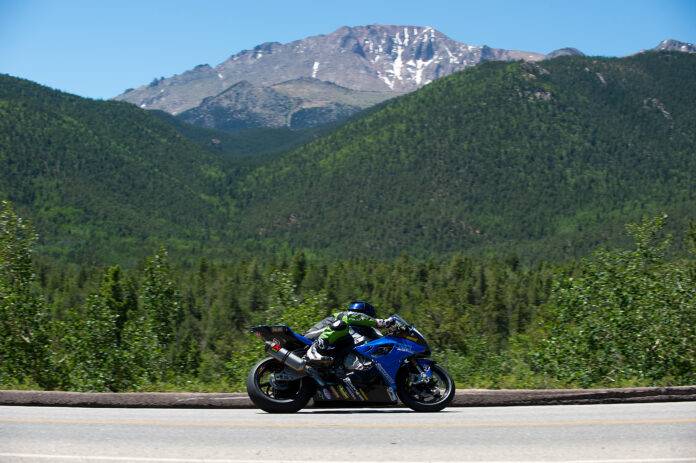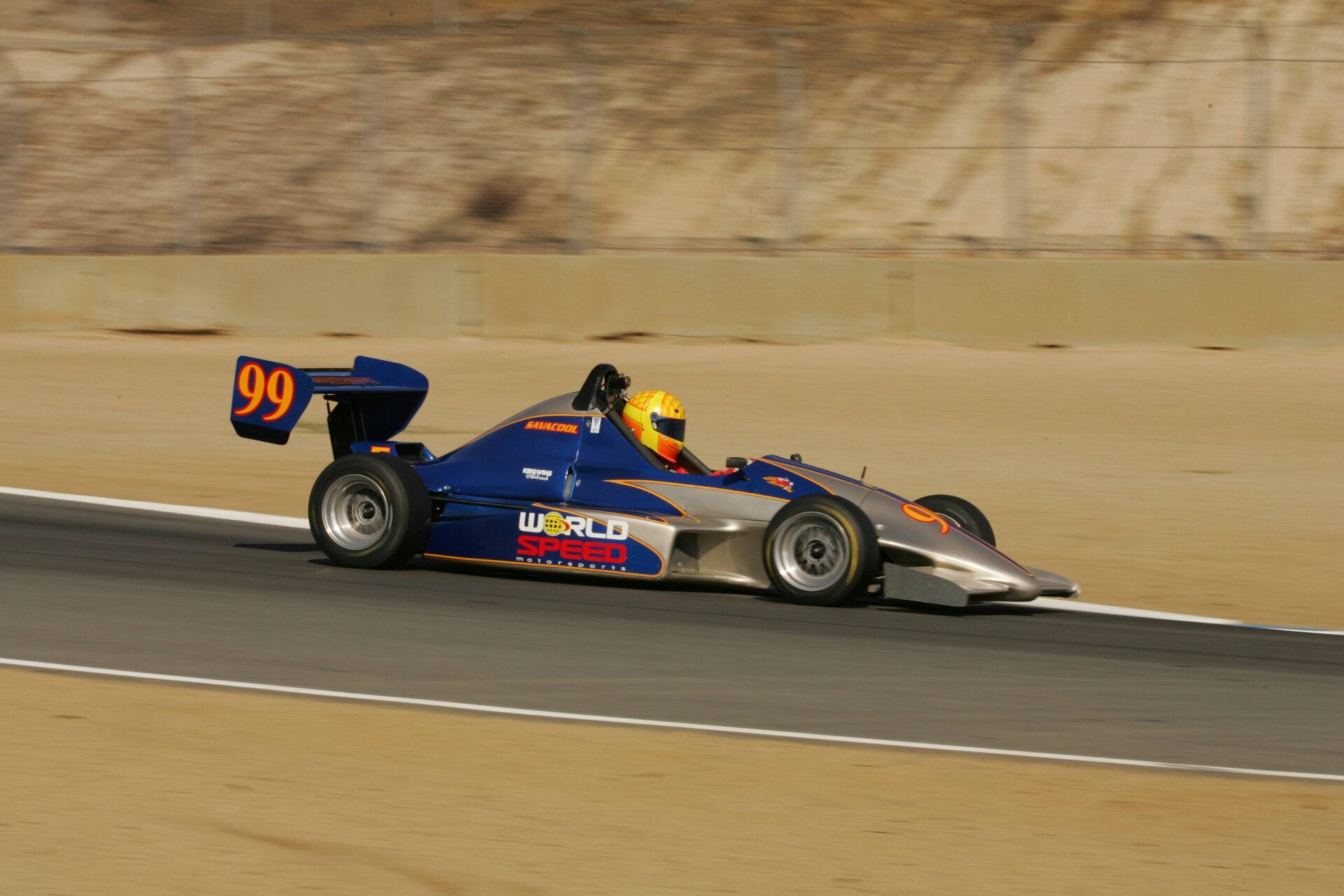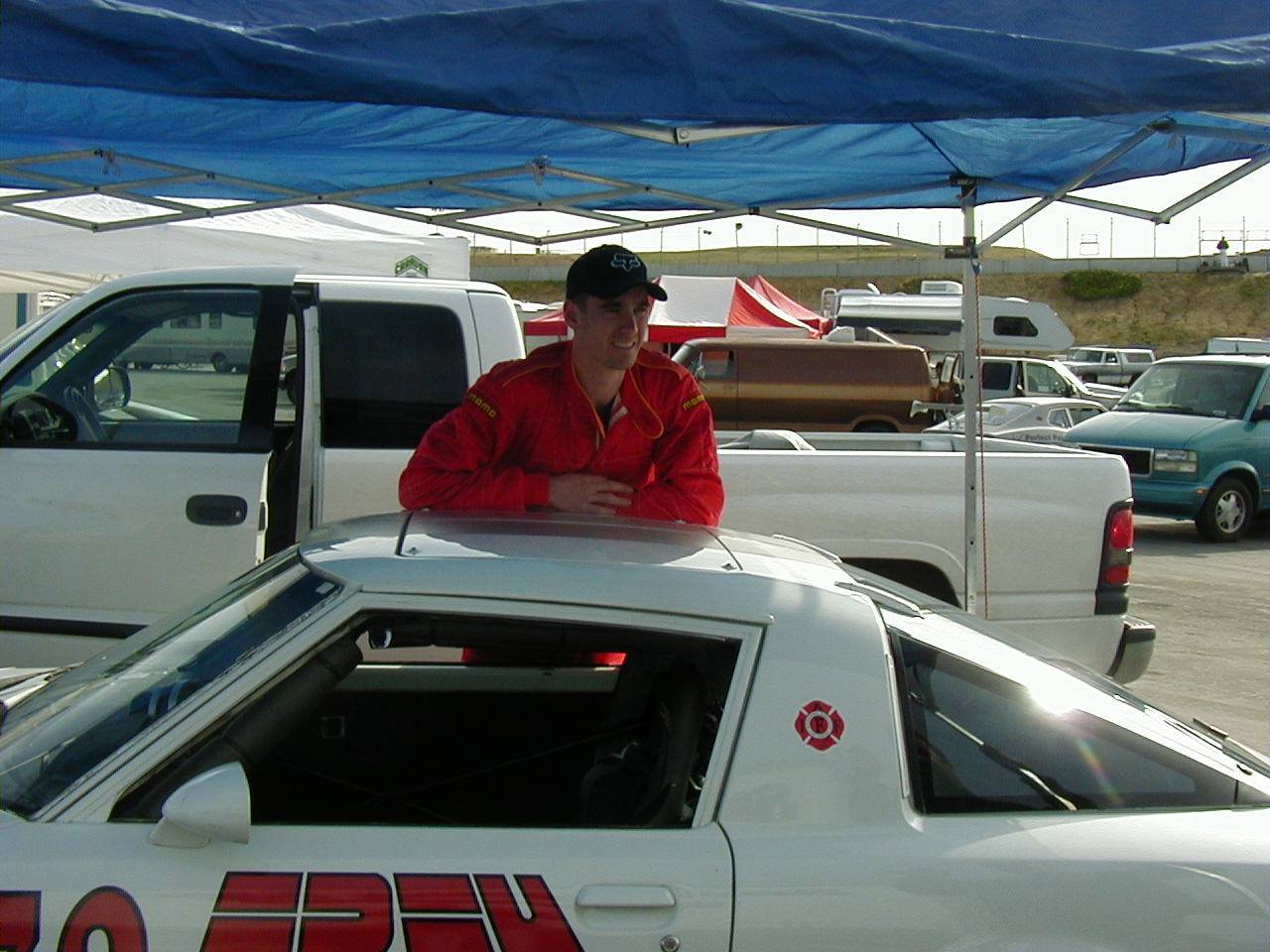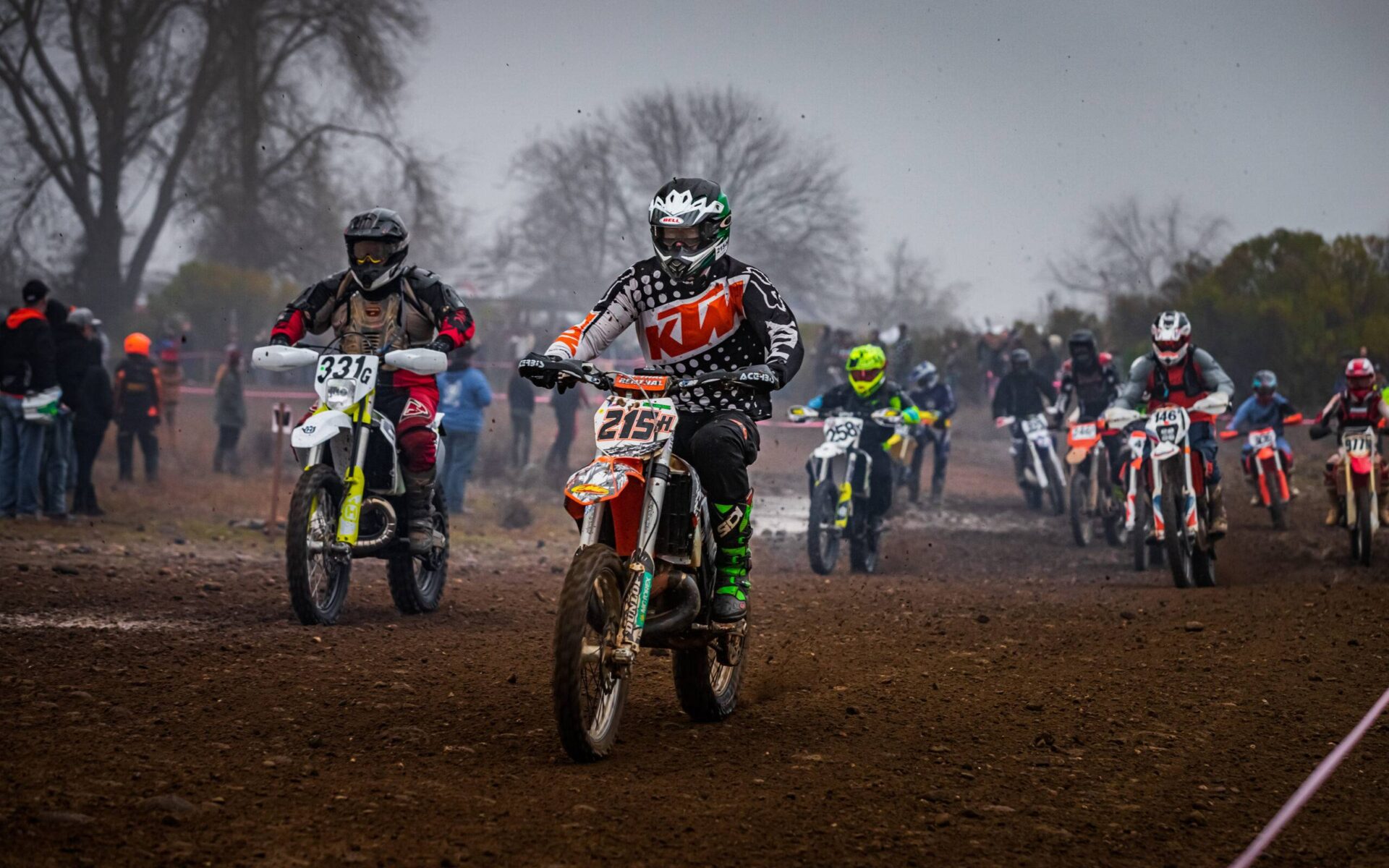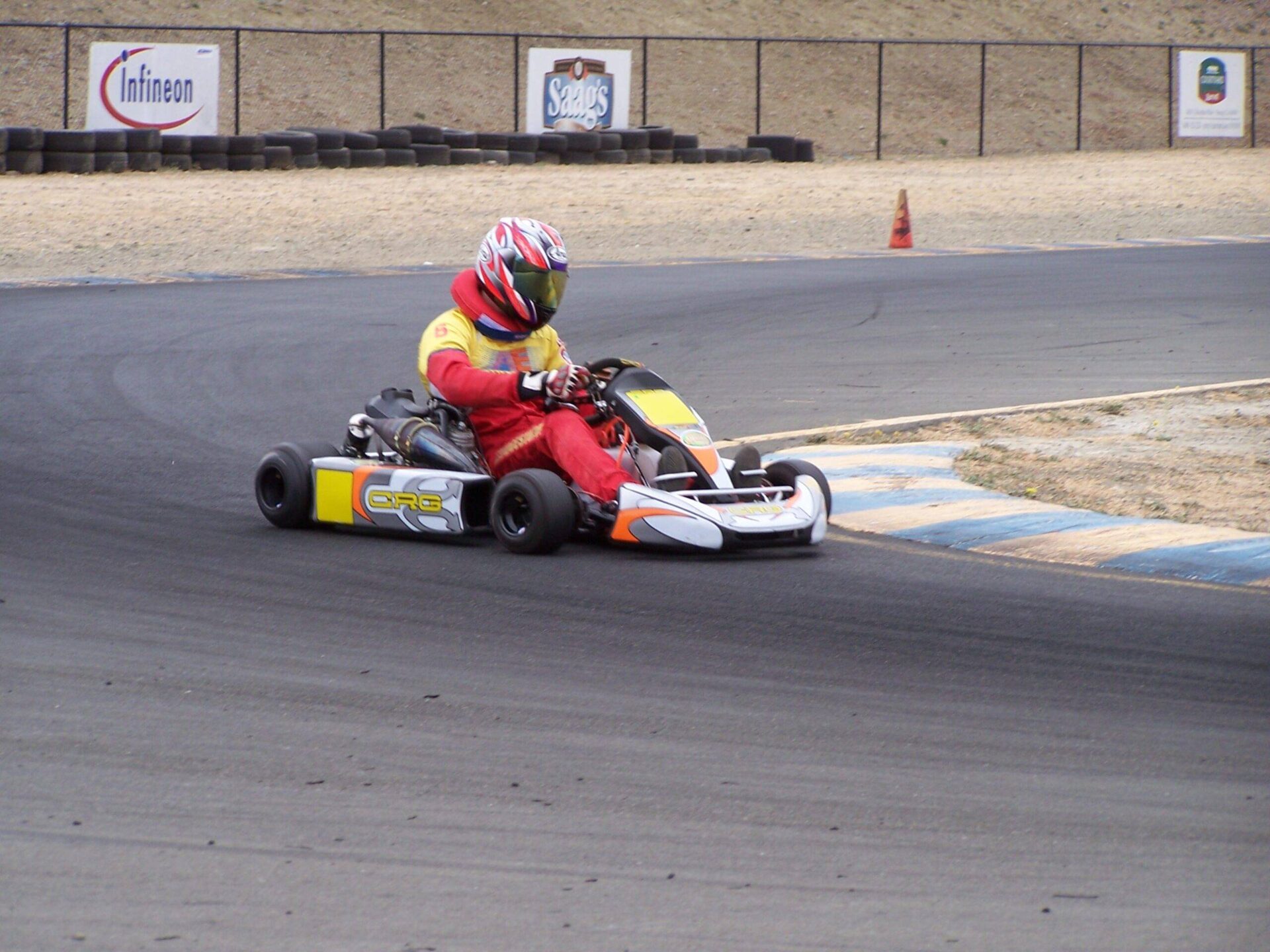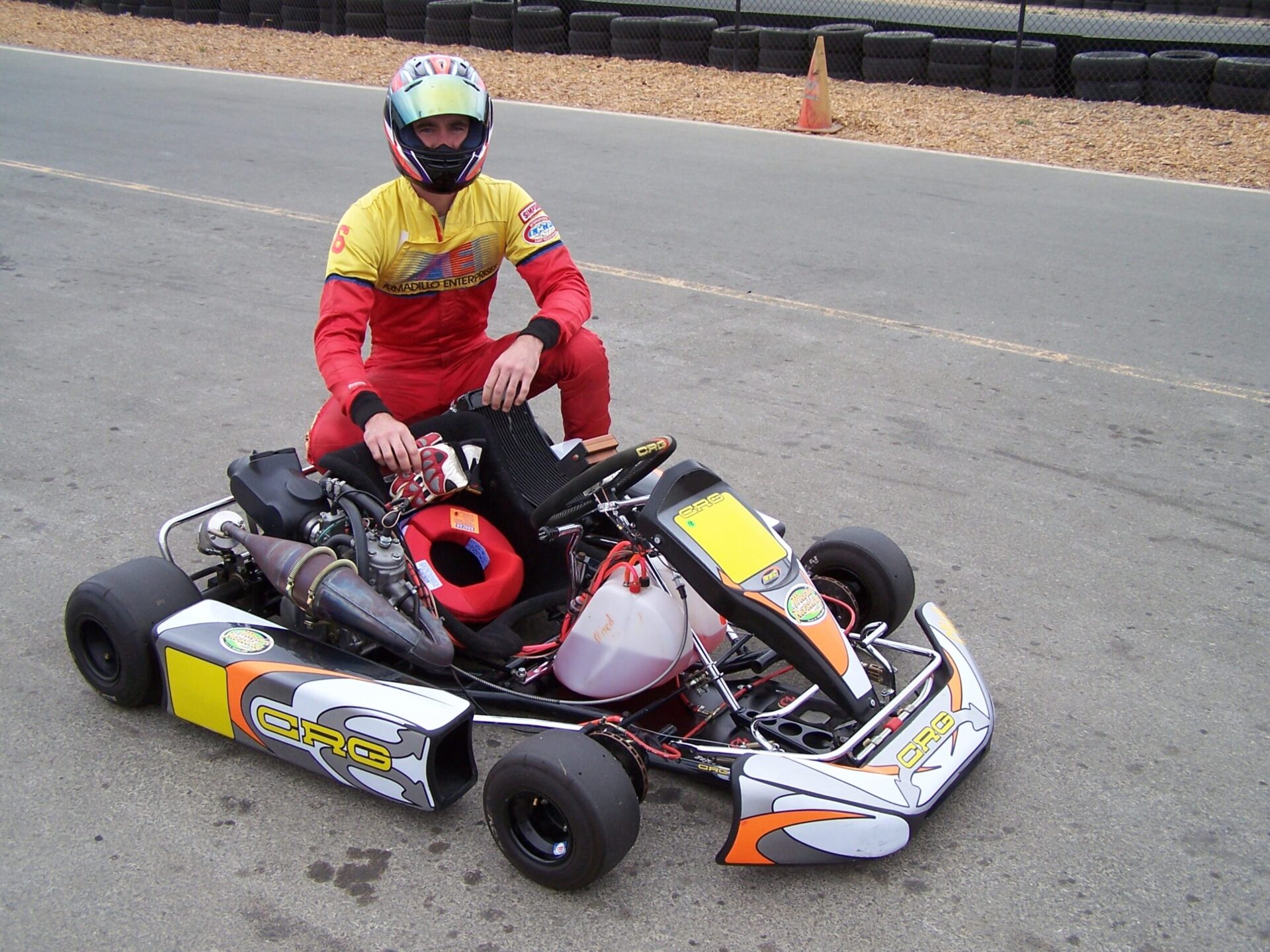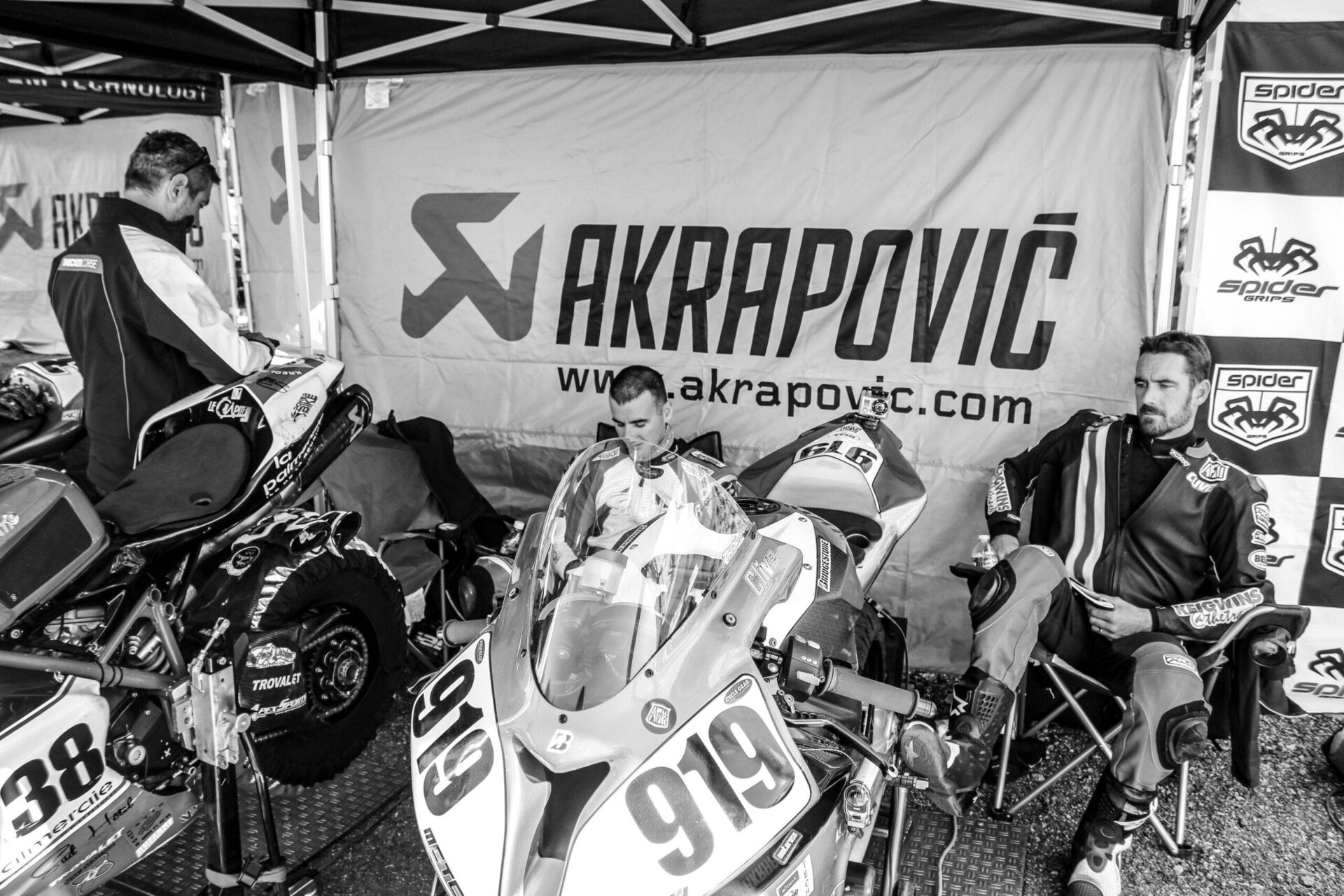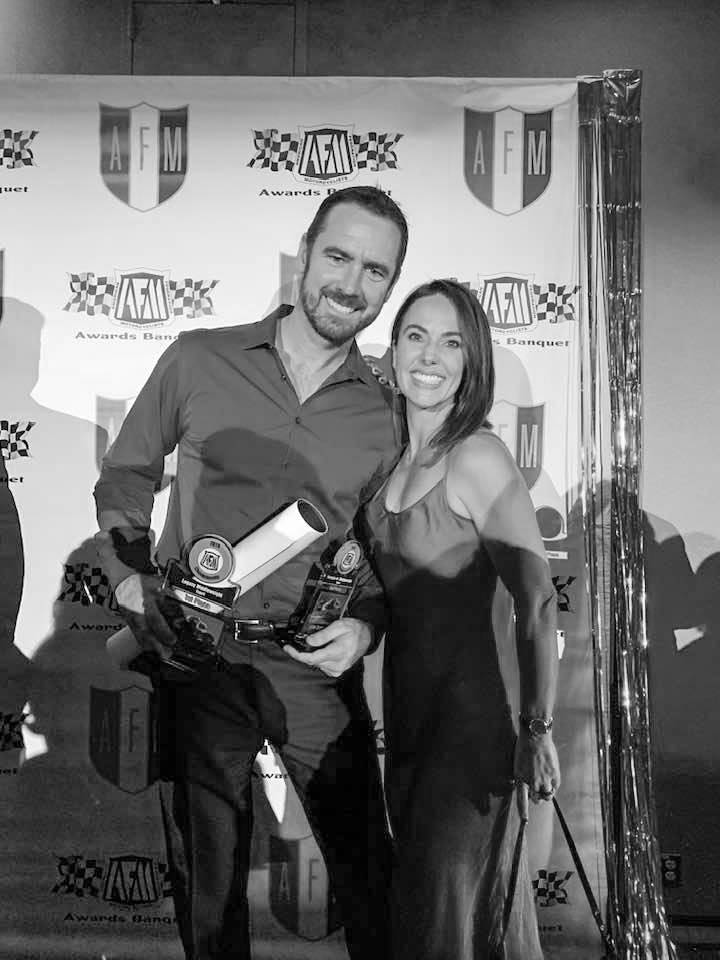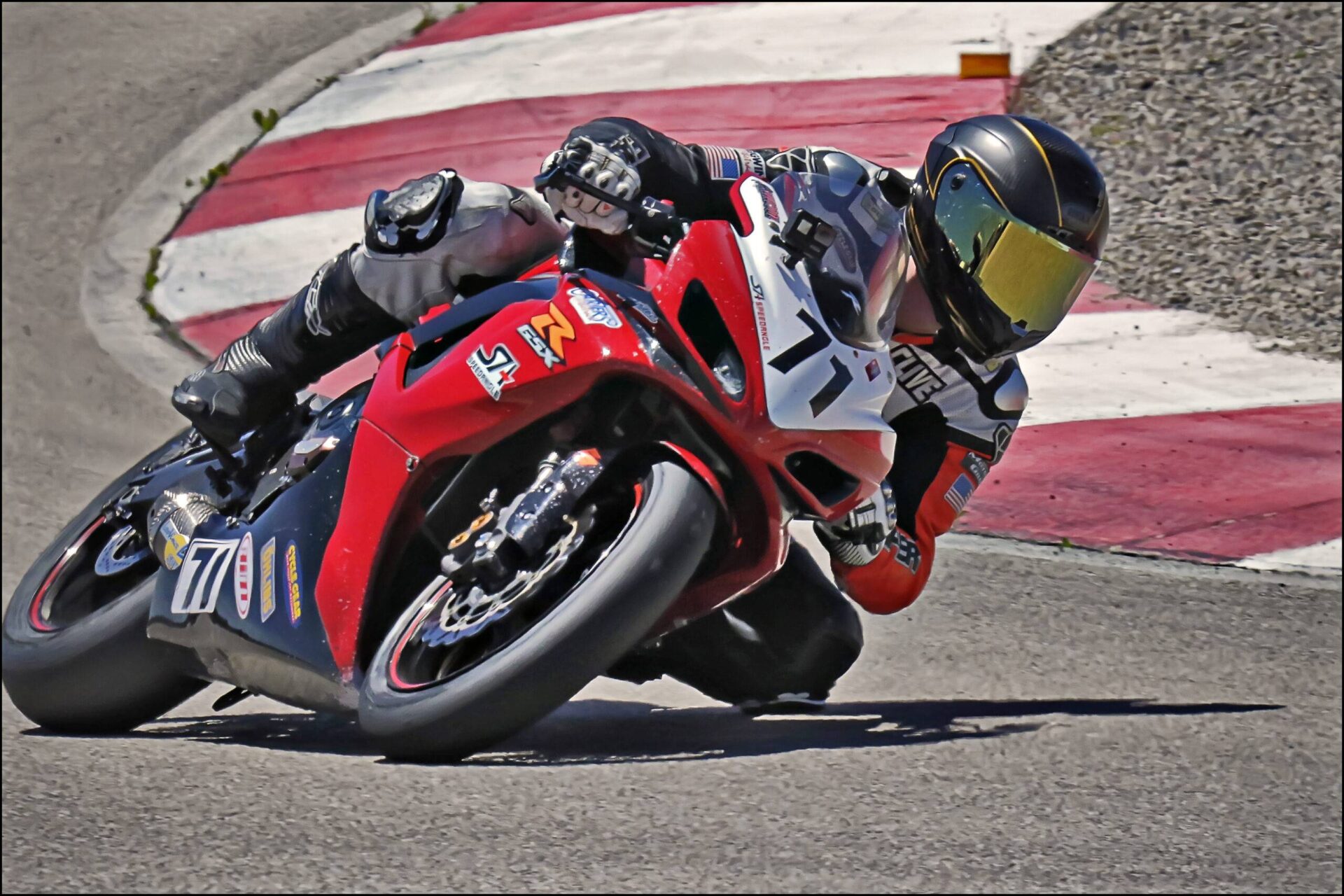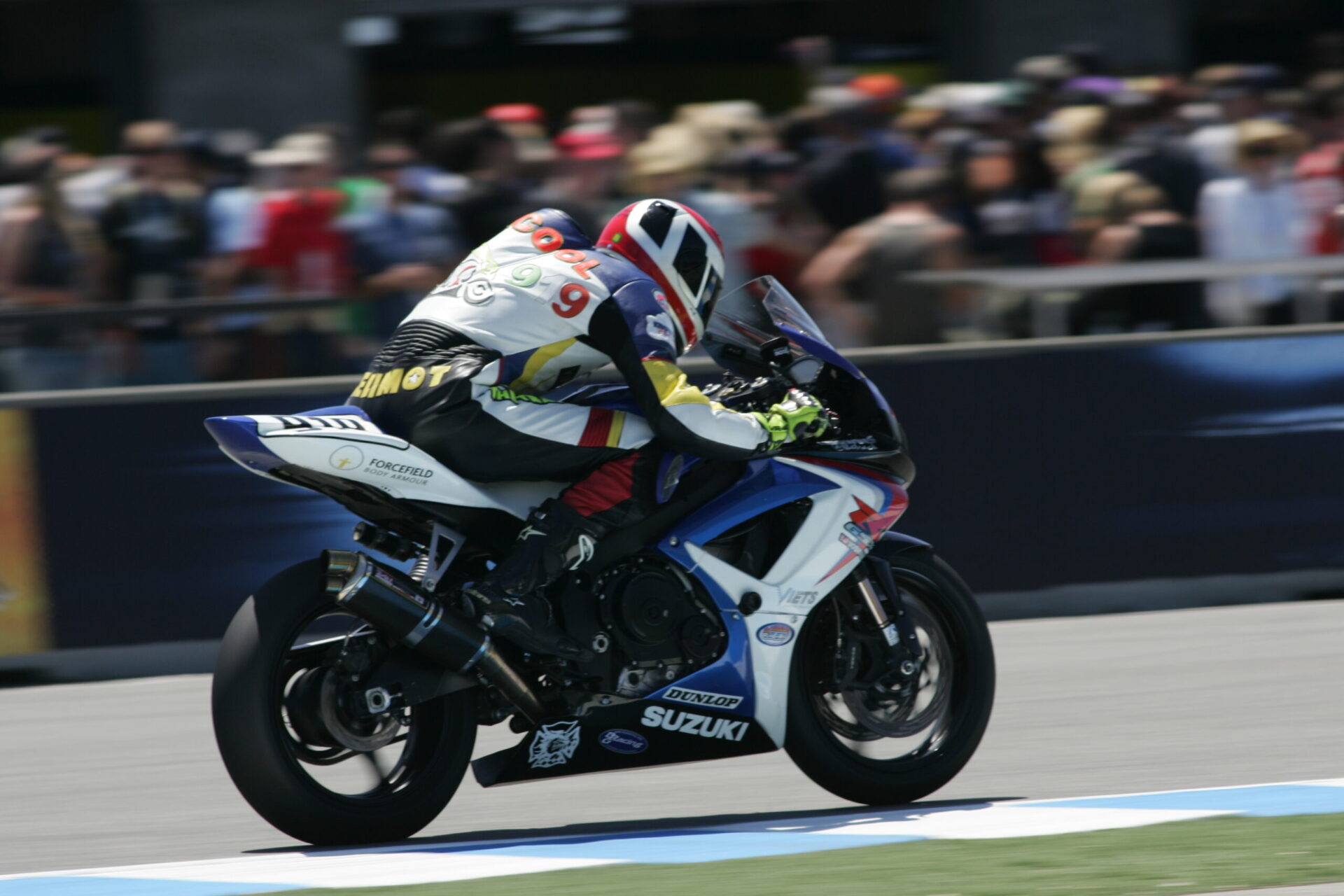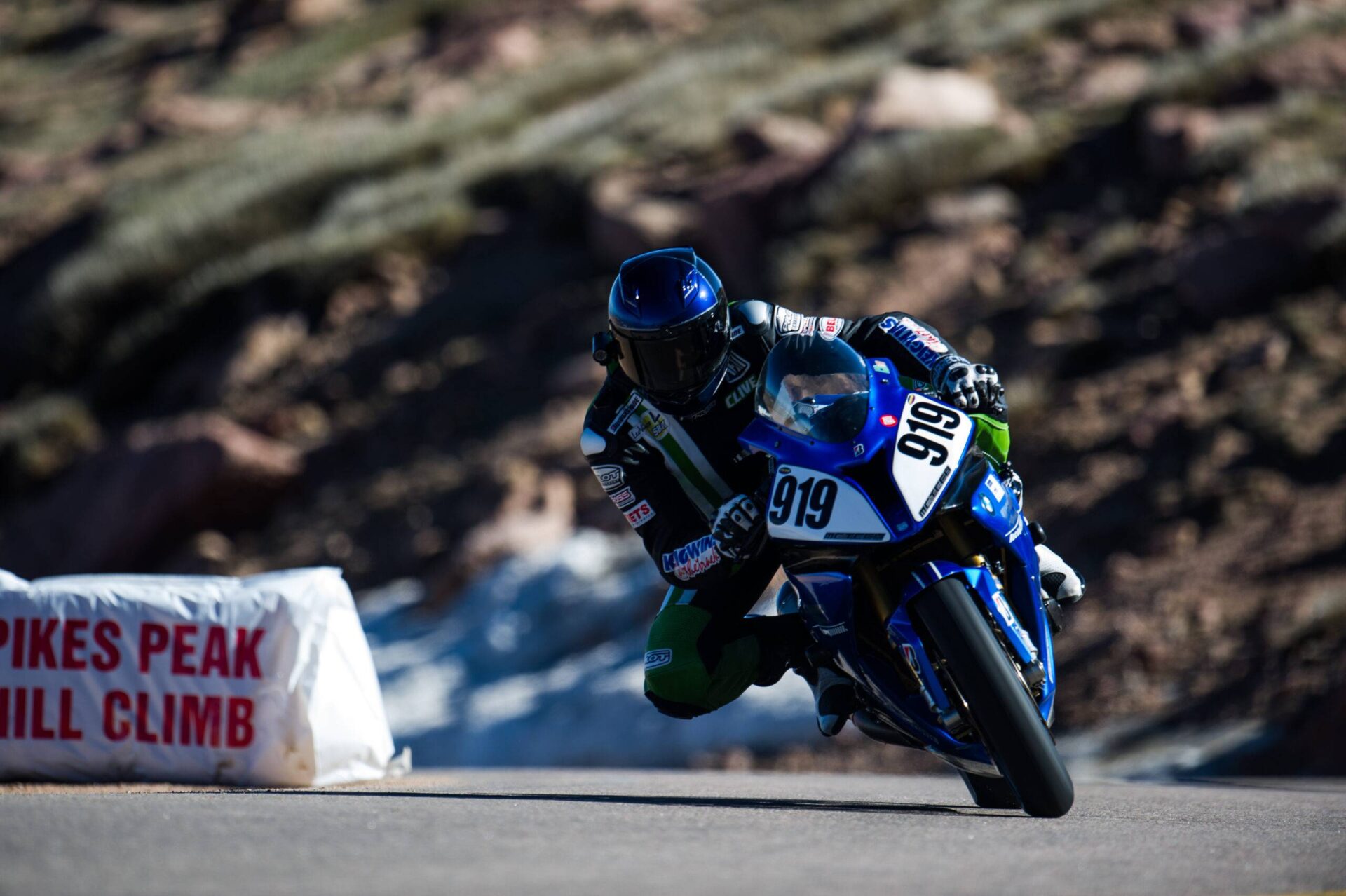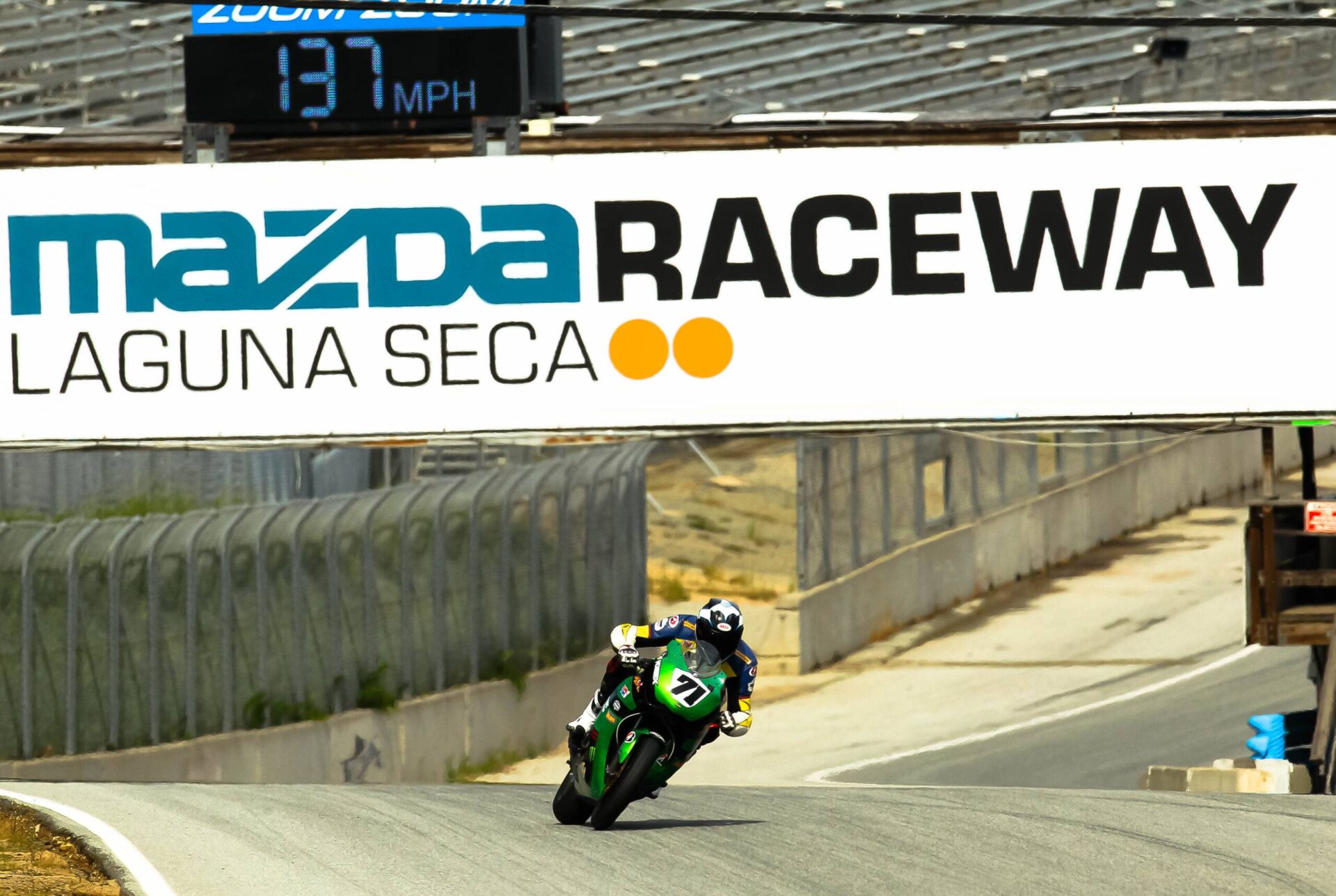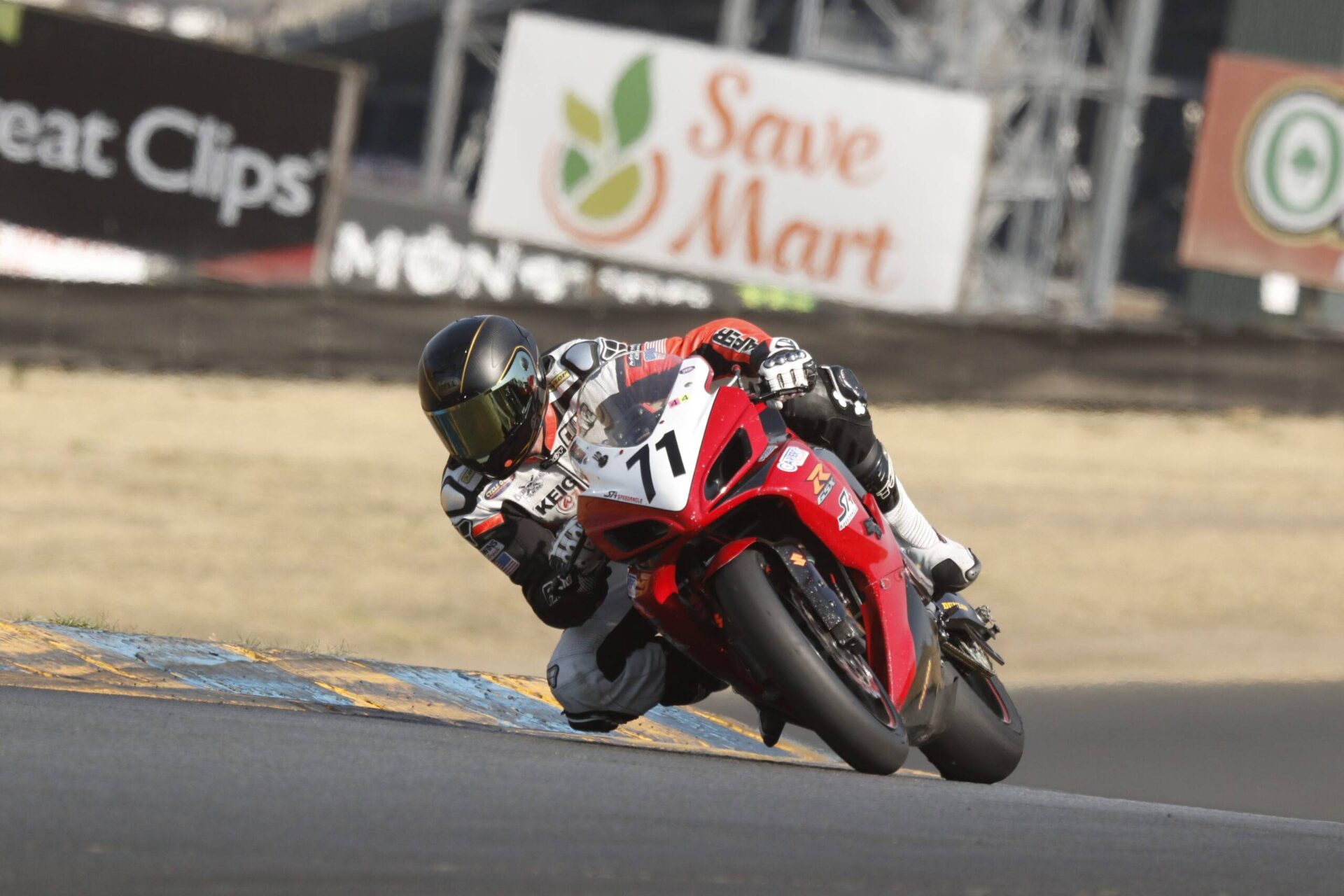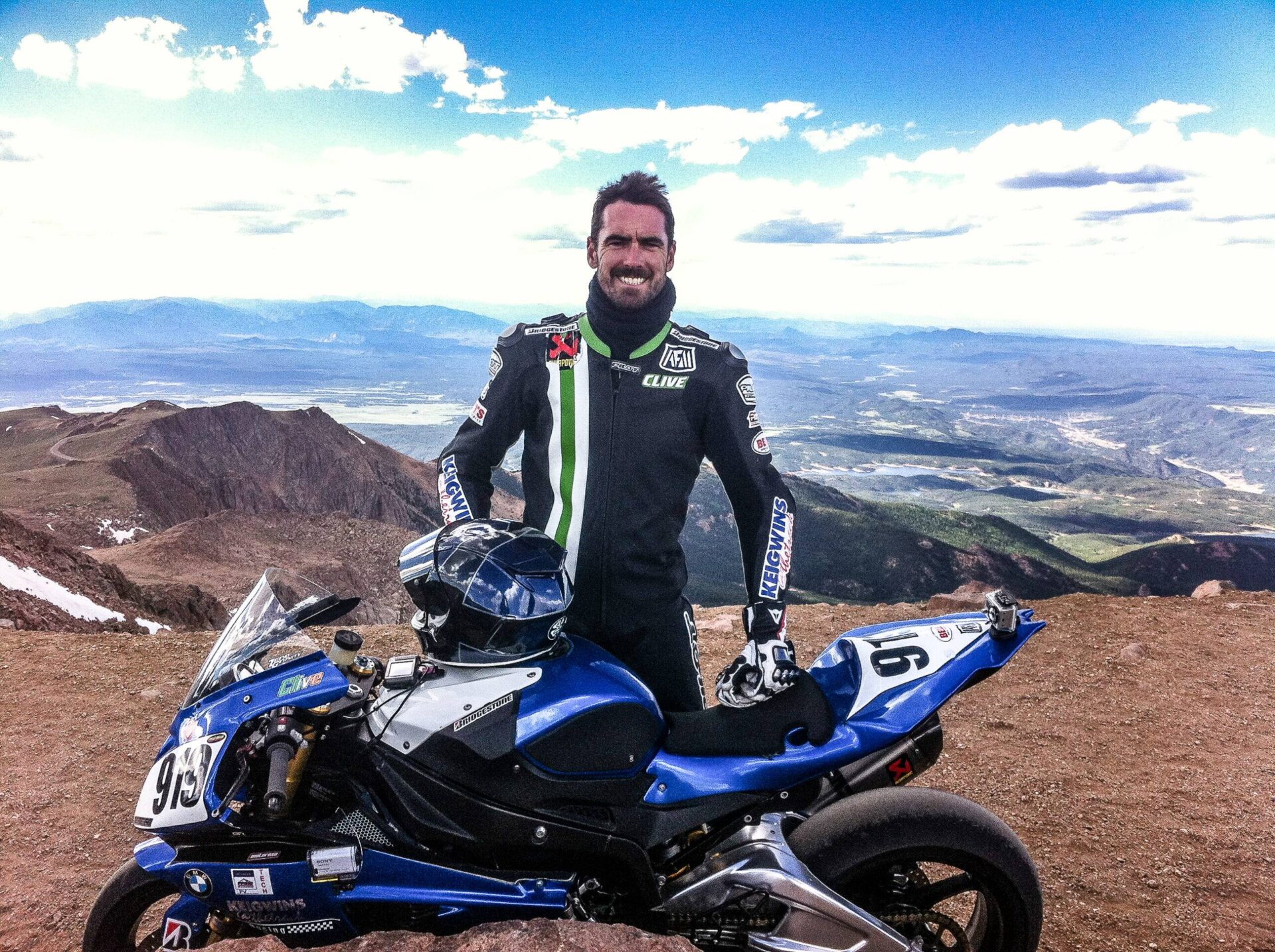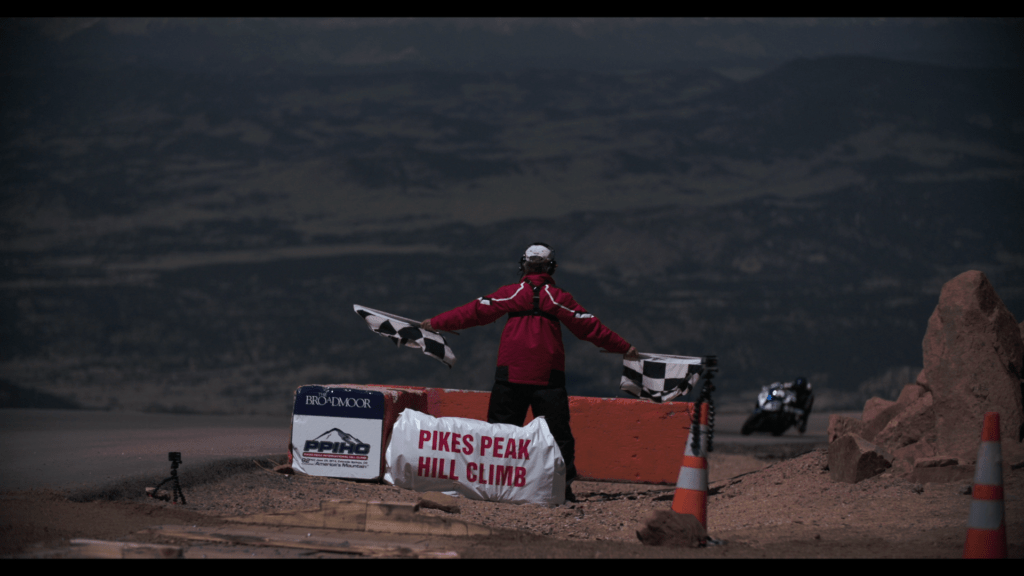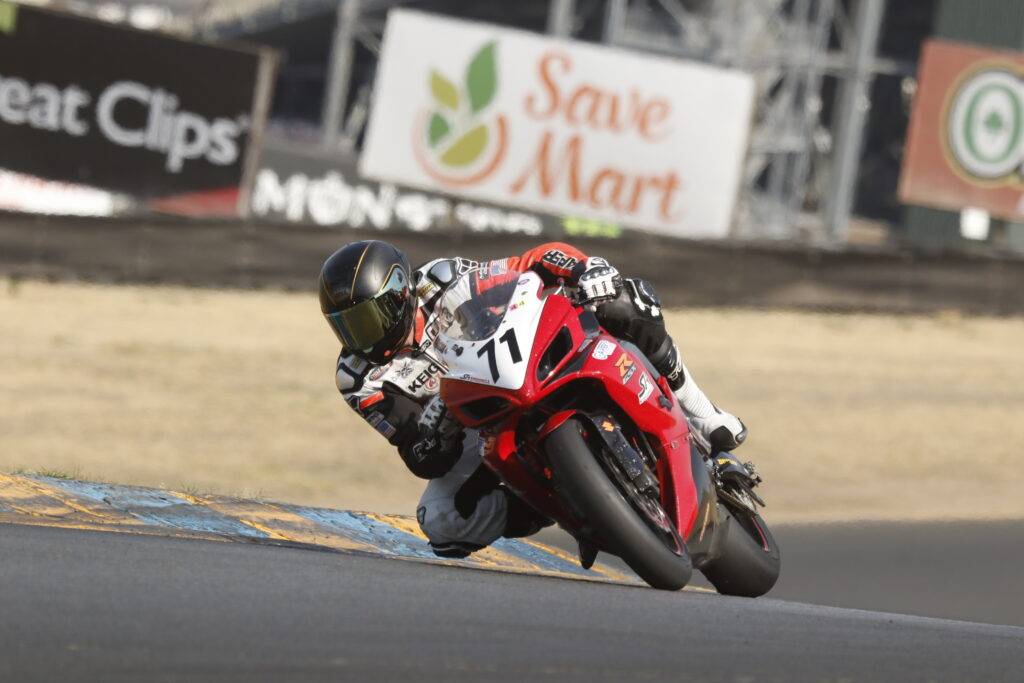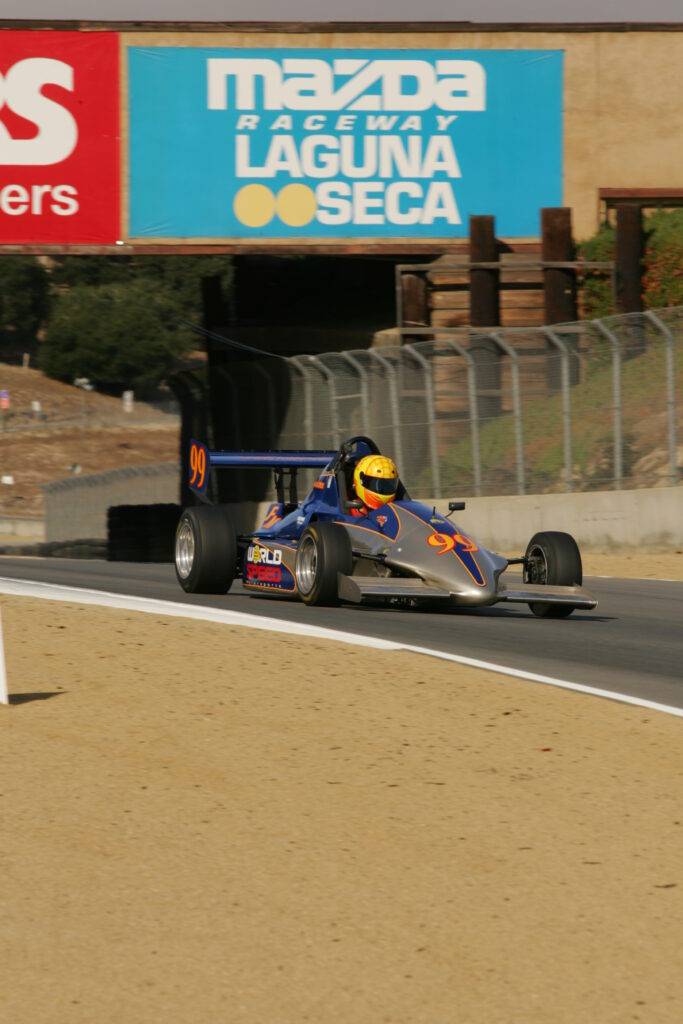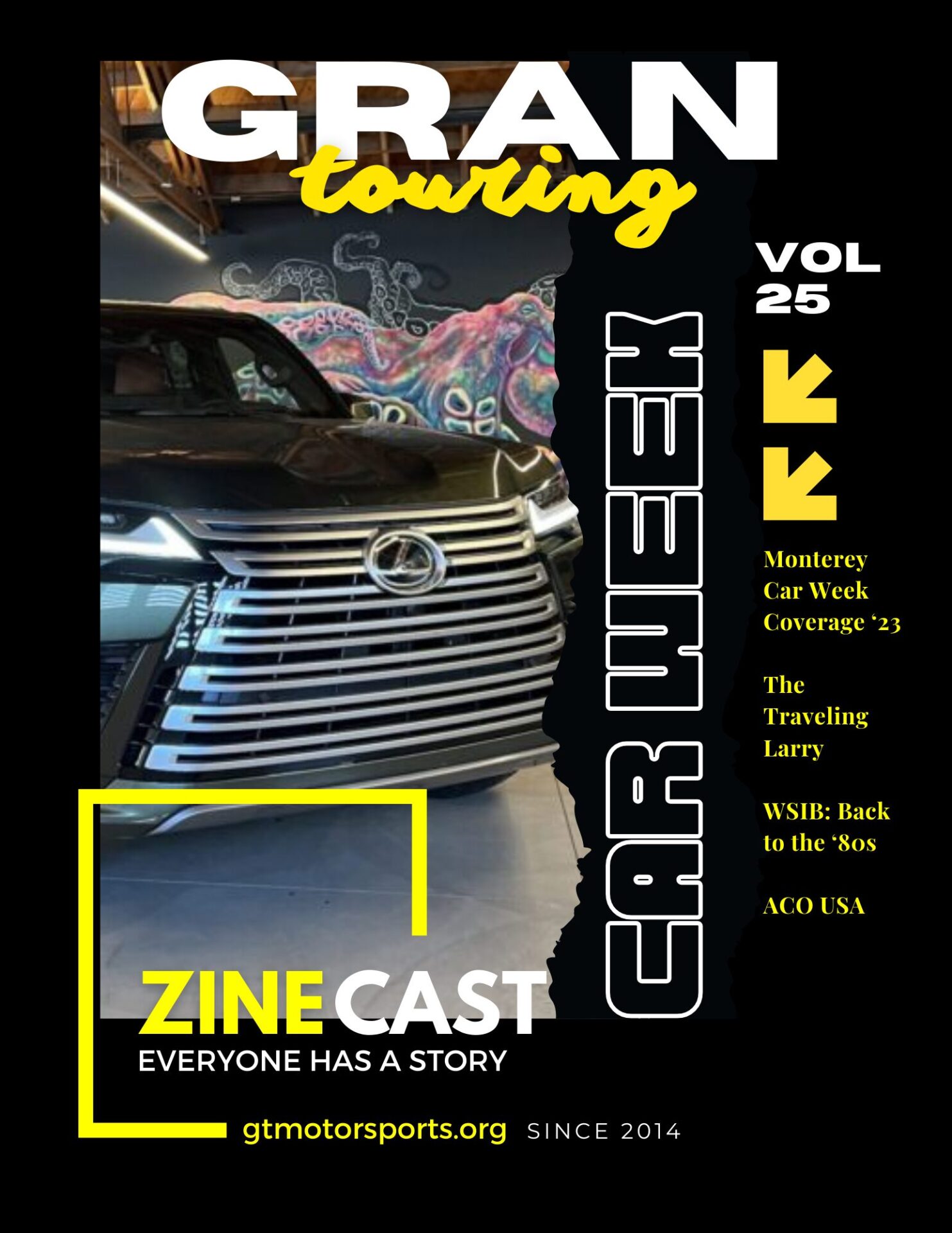Our guest tonight started his racing career as a teenager with Karts in the ‘90s, moving to the West Coast Star Mazda series racing Formula Mazdas in 2003, where he finished third overall and won rookie of the year in 2006.
In 2008, he turned his attention to Motorcycles and started racing with the American Federation of Motorcyclists (AFM) which is the oldest motorcycle road racing club in the United States, founded in 1954, and became an expert licensed racer within one season.
Along with many racing wins and championships in a variety of motorsports, today Clive Savacool finds himself after several decades as a Paramedic and part of the Fire Service, still behind the handlebars of Motorcycles and is a Member of the AFM Board of Directors assisting in overseeing safe and productive operations of the racing club. And he’s here to talk to us about why you should consider going to the track … with your bike!
Tune in everywhere you stream, download or listen!
 |  |  |
- Spotlight
- Notes
- Bio
- Transcript
- Highlights
- Learn More
Spotlight
Clive Savacool - Board of Directors for American Federation of Motorcyclists (AFM)
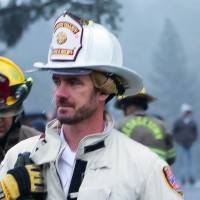
Clive Savacool finds himself after several decades as a Paramedic and part of the Fire Service, still behind the handlebars of Motorcycles and is a Member of the AFM Board of Directors assisting in overseeing safe and productive operations of the racing club.
Contact: Clive Savacool at clive@logrx.com | N/A | Visit Online!![]()
![]()
Notes
- Some people say that the transition from Karts to Open Wheel Racing “isn’t too different” what were your experiences like in the Star Mazda Series?
- What made you transition from Road Racing Cars to Bikes? Is there any correlation between racing a car on track to racing a bike? Or was it like starting all over again?
- Tell us more about the AFM, is it similar to AMA events? Or more focused on regional racing?
- Let’s talk about “instructing” at Motorcycle Track Days
- Tell us about the Pikes Peak experience!
and much, much more!
Bio
- Kart racing champion in the ’90s
- 2003-2006 Raced SCCA in the Formula Mazda class and the West Coast Star Mazda Series, finishing third for the season and winning rookie of the year in 2006
- 2008 I switched to motorcycles and started racing with the American Federation of Motorcyclists (AFM) winning several of the Novice races my first year and moving up to an Expert rider in 2009
- 2009 I was hired with a track-day/riding school organization that I still teach with, and as a paramedic I created a first aid class for track-day instructors so they can assist injured riders until an ambulance arrives. There will be an article about my class in Road Racing World magazine coming out this year.
- 2014 I competed in the Pikes Peak International Hill Climb, qualifying top ten and finishing 12th in the Open Motorcycle Class
- 2019 I won the AFM championship in the Legacy Middleweight Expert class
- 2023 I was elected to the AFM Board of Directors
- 2023 I’m finishing restoration of a 1959 Devin that I will be racing in vintage races here in California
Transcript
Crew Chief Brad: [00:00:00] BreakFix podcast is all about capturing the living history of people from all over the autosphere, from wrench turners and racers to artists, authors, designers, and everything in between. Our goal is to inspire a new generation of petrolheads that wonder. How did they get that job or become that person?
The road to success is paved by all of us because everyone has a story.
Crew Chief Eric: Our guest tonight started his racing career as a teenager in go karts in the 1990s, moving to the West Coast Star Mazda Series racing Formula Mazdas in 2003, where he finished third overall and won Rookie of the Year in 2006. In 2008, he turned his attention to motorcycles and started racing with the American Federation of Motorcyclists, which is the oldest motorcycle road racing club in the United States.
Marissa Cannon: Along with many racing wins and championships, today Clive Savicool finds himself after several decades as a paramedic and part of the fire service, [00:01:00] still behind the handlebars of motorcycles and is a member of the AFM board of directors to assist in overseeing staff and productive operations of the racing club.
And he’s here to talk to us about why you should consider going to the track with your bike.
Crew Chief Eric: And joining me as co host tonight is Marissa Cannon, GTM club member and Northeast Region Chief who also comes from a background in motorcycle racing.
Marissa Cannon: So with that, let’s welcome Clive to Break Fix.
Clive Savacool: Thank you guys for having me.
Um, love your show.
Crew Chief Eric: Welcome Clive. So like all good Petrelhead origin stories, tell us about Clive. How did you come into racing? Did you grow up in a racing family? What made you a Petrelhead? Did you start as a kid or did you come into it later in life?
Clive Savacool: Yeah, I started as a kid, my uncle raced cars, he raced motorcycles and he kind of helped raise me.
My dad was big into motorcycles as well. And it just really, really intrigued me. I’d go to Laguna Seca Raceway, Sears Point Raceway. And I was just like five and six. Met Carol Shelby, Dan Gurney when I was just a little tiny kid, you [00:02:00] know? And, and so I grew up around, you know, I mowed lawns for like two years to save up my first racing cart.
It’s always been a blast for me. And then as a firefighter, later on as a fire chief, honestly, getting on the track was a huge stress reliever. I used to say it was my meditation time. Cause didn’t have to supervise anybody. Didn’t have to deal with any disciplinary issues, employees, no major disasters.
Just go out and have fun with my buddies, the racetrack. So it grew from a kid’s standpoint.
Crew Chief Eric: So you cut your teeth and go karts, and then you made a transition to formula Mazda’s, which is like. A huge leap. Did you even take an intermediary step until let’s say like a Miata or something else production based?
Clive Savacool: Well you should ask, I actually did one season in an RX 7 with SCCA on the west coast San Francisco region. I was too big for the Miata. I’m 6’4 so didn’t quite fit in that car. It was fun, but going from karts… Cars really felt kind of like slow motion, like a sedan on the track. It was fun getting to go to my childhood dream tracks, Laguna Seca, Sears Boynton, getting to be in a car on it, but the jump to Formula Mazda was to get something [00:03:00] faster and more similar to a racing cart.
Crew Chief Eric: And some people will say the transition from go karting to open wheel racing isn’t too different. Would you agree with that?
Clive Savacool: Yeah, that’s spot on. The RX 7, very different, very slow. If you start to spin out, it feels like it’s an hour. It just takes forever was the formula Mazda. It handled very much like a racing cart, just the responsiveness, the fact you’re doing left foot braking in a formula Mazda, it translated very well.
And that’s why I was pretty successful out of the gate. So I raced with SCCA for a few years and then got to the West coast star Mazda series. In 2006, that last year, I don’t think I ever finished off the podium once.
Marissa Cannon: That is quite the accomplishment.
Clive Savacool: Yeah, I give it credit to being in a cart as a kid, the concrete in your brain is still wet.
And so you learn those skills. You learn the feel of a car, traction limits, and so on. And I also had a great mentor as my uncle and the things he taught me lasted all the way in through motorcycle racing.
Marissa Cannon: Can you elaborate a little more on like what kind of cars are in the Star Massa series, because you said you’re too big for Miata.
I’m curious.
Clive Savacool: So yeah, [00:04:00] the Formula Mazda cars, actually you’re sitting on the ground and you mold a seat. It’s quite a process to actually form a seat around you because you’re buckled in like you’re getting in the space shuttle. I basically had a molded seat that sat me down very low. There was actually plenty of leg room.
So the Miata would have been a lot tighter fit than the Formula Mazda was. I can’t tell you what a modern, you know, Formula One car, IndyCar might be like. I don’t think there’s many Formula 1 racers over six feet, but yeah, actually fitting it pretty good.
Crew Chief Eric: I had your height. I’m impressed that you passed the broomstick test because that’s an age old SCCA thing for open wheel cars, right?
Top of the roll hoop down to what would be the windshield above the steering wheel. You must’ve had the perfect setup.
Clive Savacool: Yeah. I just had that seat as low as possible. Cause if you didn’t have a seat in there at all, you would’ve been pretty low in the car. So it worked well.
Crew Chief Eric: So what did you learn? From the transition from one discipline to the other, from carting to open wheel, before you went to bikes, for instance, every discipline brings something to the table.
So carting, they say is where you really develop your race craft because you have no speed. The carts [00:05:00] are supposed to all be the same. Everything’s got momentum, but they’re momentum machines. But when you go to something like a formula Mazda, now your door to door, literally wheel to wheel, because there’s no fenders, what did you take with you from carting?
And then what. Did you graduate with from four wheels to two wheels
Clive Savacool: carts were amazing in that everything’s happening at a faster speed, not literal speed, like miles per hour, but just the fact that if the cart’s going to spin out, it’s going to be faster than in a car. If you’re passing somebody, you set them up quicker than you would like in a car.
So I think you learn at a faster rate. So when you get into a car, things are actually slowed down for you. Even the formula Mazda, things were slowed down a bit. The carting really just. Get your brain ready to handle the cars. And so when I first started racing formula Mazdas, I felt like I had a huge leg up on some of the other rookies.
Cause it previous experience continuing on to motorcycles, honestly, what really helped me and my uncle taught me this from day one is being smooth. And so you can see some guys they’ll get a car on a track, even with some motorcycle racers, and they’ll have the back tire a couple [00:06:00] inches off the ground, sliding sideways, but it’s hard to be consistent.
When you’re on the edge like that, whereas when you’re smooth and you hit the line, you hit your marks every time out, it just translates into speed and consistency. What I was taught in racing carts, I took into car racing and then going to bikes, even though it’s completely different than cars, I still was able to focus on being smooth, being smooth on the brakes, being smooth, your body positioning.
It, it all makes a big difference.
Marissa Cannon: I’ve been around my fair share of motorcycle racing over the years. And to see that it’s like, as much as car racing is something that is beautiful and fluid, motorcycle racing is ballet. It’s something that you just see. It’s so elegant. It takes a lot of courage. So explains why you’re a firefighter and a paramedic going into that.
You know, it takes a lot of that to take everything that you’ve done in a car and say, Hey, you know what? I’m going to try this on two wheels. Only some of the bigger names who’ve you’ve seen move from either two wheels to four or 42. What was the hardest part of your transition from four to two wheel racing?
Crew Chief Eric: And to dovetail off of that, what was the [00:07:00] impetus for leaving four wheel racing to go to bikes?
Clive Savacool: Racing the cars, it’s kind of like that top point, like 2006. And maybe around that time I bought my first motorcycle. So I would have been, I don’t know, 27, 28 years old. And I’d never had a motorcycle before that.
I didn’t get a small one. I got a leader bike, a Honda RC 51, still my favorite bike on the planet. That’s
Marissa Cannon: a great bike. Thanks.
Clive Savacool: I love it. It was my favorite. And of course my brain is like, well, I should just do a track day with it. I actually went to a school with a company I still teach for. I went to their school and right out of the gate, my brain was already used to being on a track, was already used to going fast.
It already was programmed to sense the limits of adhesion with the tire and so on. And so now it’s just the mechanics of. Body positioning and all the differences between cars and bikes. I just loved it on top of the motorcycle side of it. I felt like I fit in better with the motorcycle crowd, like in the pits, the guys I met, I still hang out with today, an amazing group of people that I’m still up close with.
And so I think that was the impetus. And so then I was looking also like how [00:08:00] much I spend on a car racing over a weekend where you essentially get four sessions, two practice, one qualifying in the race. And that’s it. Whereas you could spend all day on the track with a motorcycle, then put it away. And it’s still in great shape for the next time versus cars.
You’re constantly working on them. You need a team. And so the cost factor was part of it, the fun factor, the people. And so I think that’s what slowly transmission me to bikes. And for a period, I did both. For a couple of years. And then I was like, what am I doing with these cars? It’s killing me financially.
And I just have more fun with the bikes.
Crew Chief Eric: Did you make a shift to production based cars doing like HPDs or something? Or are you still running the formula Mazdas?
Clive Savacool: I still had the formula Mazda in the last race. I did was a double header Laguna Seca. And it was the one and only time I’m aware of them doing this.
They had car racing and motorcycle racing on the same days. And so I borrowed a friend’s bike. I went out and I got sixth in the motorcycle race, like 50 bikes. And then I jumped in the car and got second. There were some people there that also race in the series. And one of them said, Hey, I’m looking for [00:09:00] another formula Mazda.
And I basically came up with a deal to sell it to him. I didn’t even raise it the next day. Cause like I knew my luck, I’d crash it. If I raised it the next day when I have something lined up to buy it. And so that was kind of like, you know what, I’m out. So
Crew Chief Eric: you mentioned. The transition from cars to bikes and how bikes are more exciting and it’s more fluid, but obviously it’s more physically active than being in the car.
But there’s one other component to this that oftentimes maybe gets overlooked and that’s the risk. Would you say that the risk on bikes is higher than in cars is about the same, especially when you’re wheel to wheel with other riders?
Clive Savacool: For sure. A lot riskier. Absolutely. That doesn’t leave your mind. And honestly, I felt like over the years.
I left some speed on the table. There were times when like, okay, I’m not going to push as hard as I could, especially I raced in the Pikes Peak hill climb and there was no way I was going to get right a hundred percent in that situation. And so because of the risk factor, it does kind of hold you back.
Not everyone. But I was very conscious, especially being a paramedic, you know, I’ve seen the downsides. And the flip side, you’re on a racetrack, you have no cross traffic, you have no cars, there’s lots of [00:10:00] runoff, you’ve medical standby around you, you have the best equipment, like you have racing suits now that have airbags in them.
And so the safety is probably as good as it can get considering what you’re doing. And so from that aspect, we do make sure we’re taking precautions to make sure we’re safe.
Marissa Cannon: Are you using like the neck brace that they came out with to, to go with your suit or are you just doing the airbag system?
Clive Savacool: I have a vest.
I don’t have the neck brace. And then the new suits with the company I work with, they have the airbags built into the suit themselves.
Crew Chief Eric: When you were in the four wheeled world outside of the go karts, you were pretty loyal. I heard Mazda, Mazda, Mazda. So are you brand loyal when it comes to bikes? What kind of bikes are you running?
What are you racing out there?
Clive Savacool: Had a little brand loyalty for a bit with BMW because they sponsored me a little bit after the Pikes Peak Hill Climb. Because I was the first person I’m aware of, maybe the only one to ever race a BMW S1000RR. Pikes Peak. And so the year after that, I got a bike from them.
Haven’t had brand loyalty. Like it’s just a favorite, but I’ve kind of gone back and forth to Suzuki. My first race bike was Suzuki, and then I tried a Yamaha, and then I [00:11:00] went to the BMW, then I tried a Honda, and I went back to the Suzuki because it just felt like an all around good bike, especially for someone my height.
The Yamaha R6 was an amazing bike, but it was just underpowered for someone, 200 pounds, six foot four, you know, and the BMW was great for someone my size, but I just never fell in love with the handling on that bike. And so the Suzuki was just like an all around great bike for me. And so that’s kind of what I ended up winning my championship with the AFM.
Marissa Cannon: And that was that the 1000,
Clive Savacool: the 750, that bike is just an all around amazing bike. It’s got a good power, but it still has the handling of a middleweight bike. Figured after that, I would move up to a leader bike again. Nice. Haven’t taken that step yet.
Marissa Cannon: Yeah. I just know that the SV six fifties are really common, especially for those who are starting out in racing.
Clive Savacool: That was my first race bike. That was amazing. I love that bike. It is. And what’s funny is the lower horsepower classes. Cause I think they only have like 80 horsepower. Wouldn’t you put the better carburetors on them? The racing’s better. I think it’s partly because it’s a little bit of a spec class, but when you’ve got just a lower horsepower, you’re just dicing it up.
And I just [00:12:00] loved that with the SV650. It’s
Crew Chief Eric: like spec Miata for bikes. That’s what I’m hearing here, right?
Marissa Cannon: You pretty much nailed it on the head on that one, Eric. Could you elaborate a little more on the differentiation of the classes? Formula 40, which I believe is for riders over the age of 40.
Clive Savacool: That’s right.
Marissa Cannon: And I know that there’s the dirt bike one, the Enduros, and then the other classes like mid weight, lightweight, heavyweight.
Clive Savacool: Yeah. So with road racing, especially like with the AFM and other clubs. The classes kind of all revolve around heavyweight, which are leader bikes, middleweight, which are 600 750s and lightweight, which are the, you know, like the 400s.
And so basically those three categories are what they break off, expand and have other classes. But ultimately those are the three groups of bikes. The class I race in like formula 40, it’s 40 and over. They even have a formula 50. Thankfully I’m not old enough yet for that one. And then the legacy class that I raced in, honestly, the bike I raced in that class, I raced in the 750 superbike class too.
And the 750 production class, even the bikes that are [00:13:00] 10 years old are still rockets. The only difference is mine didn’t have track control, which I was never that big of a fan of anyway. So the classes are really kind of just a break off of those three categories. Fortunately, they do have Some little outlier ones, like I think it’s called super dinosaur.
So you have like vintage bikes, which you guys like to wrench on them. Cause of course they always break down AFM, which is a strictly women’s class. They also race in the other classes too. They’re the rock stars. So that’s been something that the AFM has really been successful at to draw in some more people.
That’s kind of the foundation this year. We are adding two classes with Indians and Harleys to try and see if we can kind of go off the popularity of the Moto America has gotten out of it.
Marissa Cannon: Interesting.
Crew Chief Eric: I’m not a motorcycle guy. I’ve always been a four wheel guy, but I do appreciate them. And they are works of engineering art when you look at them and whatnot, but it’s sometimes it’s really hard to tell them apart outside of, you know, what’s on the side of the gas tank.
I mean, I know a BMW from a Triumph from a Honda, but when you’re out there racing, what’s it like on these different bikes? Just like, well, the handling really wasn’t there. What does that exactly mean? Because your contact patch in a [00:14:00] corner is miniscule compared to what I’m used to on, you know, a 275. R seven Hoosier or something, you know what I mean?
So it’s like worlds apart, you know, Mars and Venus. So how do you translate that to somebody like myself or some of our listeners that are trying to figure out, what do you mean by the differences in all these bikes?
Clive Savacool: It’s all feel, which honestly I think was probably harder for me with the bikes because I didn’t have my first motorcycles.
I was in my late twenties and now I just went ahead first and racing with it. You trail break a lot when you’re on motorcycles more than probably a lot of people think who don’t race them. For example, the BMW and I had the first generation. So it was their first one of the game. I’m sure they’re a lot better now, but you just didn’t have the front end feel on the front end when you’re going in on the brakes.
And so you really couldn’t tell when it was going to break away. And probably a good example for the car. People is when you’re in a turn and you’re getting on the throttle and you can kind of. Feel the rear end start to step out on you and a lot of car guys, they know that feeling. They know when they’re getting close to the rear end coming out, just coming a little sideways.
And so it’s kind of a similar [00:15:00] feeling to where you can tell when the front end is going to slip out and you’re going to low side. And some bikes just have better feel than others. Like the Honda, I raced the CBR 1000 that had amazing front end feel. I loved that bike. Some are just better than others.
The Suzuki was a good balance of all of that.
Crew Chief Eric: Talking about rotation versus the car getting away from you versus drifting, right? There’s three different sort of points. If you’re coming around an apex, especially in a rear wheel drive car, a lot of us want to dial in some sort of rotation out of our cars, right?
Because it allows us to egress the corner much more quickly or put it where we want it for track out and things like that. But what it sounds like to me for the bikes is it’s all about the front end. And that’s a little bit counterintuitive. What about the rear end are bikes pretty planted in the corners because you’re applying the power and you’re just sort of feeling everything through the front suspension and through the yoke.
Clive Savacool: I probably didn’t emphasize the rear as much because that always felt easier because you’re getting on the throttle and you have a bigger contact patch in the rear. You could feel the rear sliding out a little bit. There’s this one turn at Thunder Hill Raceway turn seven. [00:16:00] And when you’re going through that, it’s almost.
Full throttle and you’re just flying. It’s probably like 130 miles a turn. And as you’re coming out of it and you’re on the throttle, your knees on the ground, you can feel the rear tire starting to slide out a little bit. And you just want to do it just a tiny bit, but you can feel that and you can really control it versus the front end.
I was never good enough to want to go into a turn and want to slide the front as I’m coming in. And so honestly, the rear felt a little bit easier. And then with traction control, it’s almost cheating with the rear sometimes. And I never Wait,
Crew Chief Eric: wait, wait, wait. Your bikes have traction control? Like you’ve just blown my mind.
Clive Savacool: The BMWs did. The Suzuki, I want to Championship did not cause I kind of didn’t like it, but yeah, all the modern race bikes, they have amazing traction control. So you’ll hear guys just come out of the corner and practically pin it. And you’ll hear the exhaust was like a popping sound when they’re just riding the traction control.
So it’s almost cheating and you can scale it back. So there’s different modes on the traction control, like race mode, wet mode in different settings to allow a certain amount of tire spin. So to your question. The front was always a way to make up a lot more time on other people. Cause you could get deeper into the corner [00:17:00] and have a higher corner speed that way.
Crew Chief Eric: Because you’ve lived in both worlds. You probably remember the lectures from the classrooms about, you know, the car and the center of gravity and how it pivots on, you know, that pinpoint and whatnot and lateral movement under braking and acceleration, et cetera. What’s the weight transfer like on a bike?
You know, we see all those videos online with guys doing wheelies and doing endos and all, but that’s not what you’re doing on track. So. How subtle is the weight transfer and you’re part of that weight transfer. Unlike in the car. Right?
Clive Savacool: Absolutely. And Marissa hit the nail on the head that it’s like a ballet because you want to be smooth with your body as well.
Cause if you transition from one side of the bike really hard, or if you get on the brakes really hard, you’re upsetting the suspension. And so that weight transfer you just described is huge with keeping the bike. Balanced the writing coach that I’ve worked with for years, Ken Hill, he’s just amazing.
And he would teach you on the brakes of just getting on so smooth on the brakes that you could actually break deeper and get on the brakes later because you were smooth and you weren’t disrupting the brakes balance in that weight [00:18:00] transfer. So you want to be smooth with it. And you watch some of the pro riders and they go into a turn, you know, MotoGP, it’s slow motion.
They see, you see them just slowly lifting the rear tire off the ground. It’s because of how smooth they are transitioning to the brakes and minimizing. And granted, you’re going to have a ton of transition of the weight, but it’s how you do it and how smooth you are. That makes the difference.
Crew Chief Eric: You know, we joke a lot when we’re on track days with other guys, I break it to two going into turn one and you hear it all the time and you watch them from the outside and you’re like, bro, you’re not breaking up the two.
What are the breaking zones like for the bikes? And you were talking about the weight transfer. Are you moving your body towards the front, put more pressure on the front end at that point?
Clive Savacool: For me, I’m lucky because I’m tall. So I put my weight back on the bike because I’m coming to the corner. And another big thing with your body position is think about your, they call it economy of motion.
You want to limit how much you move on the bike, but you want to be the right place. So when you’re coming into a corner, you want to be on that inside part of the bike. You want your weight to be on that inside foot peg, but you don’t want to transition all that as you’re coming in the corner, you do it on the straightaway approaching that corner.
So when you get there, your weight’s already on that side [00:19:00] of the bike. And then as you get onto the brakes for me being tall, it’s easy. I get to the back of the bike, which helps limit how much the rear might come up. You essentially always get the front end diving down when you break, but the body position is huge with everything on the bikes.
And then your question about break points. It’s earlier with bikes than cars. And so that race I mentioned when I raced bikes and cars at Laguna Seca on the same day and a couple hours apart. You break much, much later in a Formula Mazda going over the front straight at Laguna Seca than you do on a bike, especially because the bike is actually going probably a little bit faster when you come to the corner.
But back to your point about the contact patch, it’s a lot smaller on the front tire of a motorcycle than four big wide slicks on a Formula Mazda. So there’s a couple of times I had to catch myself from not going too deep on the bike.
Marissa Cannon: Yeah, combine with all those calipers that you have on the Formula Mazda too, right?
Oh, yeah. Twice the
Crew Chief Eric: braking power, right? That
Clive Savacool: thing was insane.
Crew Chief Eric: You raced the Formula Mazda and your bike on the same track in the same day, and transitioning back and forth has to be an interesting dilemma. Another thing that I don’t think people take into consideration is your apex angles, your [00:20:00] entry points into a corner on the same track.
Are 180 degrees out from each other.
Clive Savacool: They’re different at times. I wouldn’t say it was insanely different, but the benefit was that the muscle memory in my head when I’m on a bike, it knows, okay, this is the trajectory I need, this is where I need to be at this apex. The bikes have more power to weight ratio.
So you probably apex a little bit later. You want to get the bike stood up so you can get on the throttle as soon as you can. Whereas the formula Mazda wasn’t really high powered. So you wanted to be smooth. And so that had an impact on the apexes and the lines of the course.
Crew Chief Eric: You memorized all the left turns at Laguna.
So you got that down, right? You knew where they were. What I’m getting at is the arc of the turns on a bike are much longer than they are in a car. Right?
Clive Savacool: Yeah. It depends too, like the leader bikes. Have sometimes a tighter apex and a slower mid corner speed because they want to carry as much speed into the corner, turn as much as possible, as quick as they can, and then get appointed down the next straightaway.
Because BMW has got [00:21:00] 200 horsepower. You want to get that throttle on with the cars. The Formula Mazda was actually pretty broad arc because it did not have that power that the motorcycles had. There were some differences, but the breaking points were definitely different. One point to your question about breaking points in the bikes is something that always stuck in my head wasn’t as much when you get on the brakes, which is important, but it’s almost more when you get off the brakes, because I wanted to make sure if I got the brakes too soon, and man, I didn’t carry enough speed in the corner.
Marissa Cannon: So speaking of carrying speed through the corner and bike related activities, you’re now an instructor or you’ve moved towards instructing like track days and stuff like that.
Clive Savacool: Yep. I’ve actually been with the same company since 2008. It’s the one I went to my first school at back in 2004. I think it was.
When I had my RC 51, I got recruited to be an instructor a few years later. And it was, it was owned by a different group then than it is now. One of the instructors I worked with back then to bind the company. So we’ve kind of stayed this family for the last almost 20 years. And we’ve made quite a good name for ourself and the reputation about the atmosphere, our events.
But yeah, so I teach with them at the schools and then we [00:22:00] have track days throughout the year, where we also always welcome people for coaching if they need some help. Yeah. It’s sort of where I transitioned away from racing just cause I’m getting a little bit older.
Marissa Cannon: For beginner track rider for motorcycle, how much would you say it costs to get into that first day on the track?
Clive Savacool: What’s great about track riding with bikes is you could just start with a bike straight off the showroom floor, go out and get a 400 for a reasonable price. You could get a used Yamaha R6 for a grand or so and take it to the track and it’s going to be just a really. Fun bike to ride the track. So you could just show up with your safety gear and your bike and you’re good to go.
You do need to do some prepping, like take the mirrors off, cover up the lights and such, or you can go all the way to the extreme. Like I did at the end, having a trailer, generators, tire warmers, extra wheels. Spare body parts, spare sub frames. The sky’s the limit if you really want to go racing serious.
But if you just want to go do a track day ride, you just need a bike, a helmet and some safety gear. That and positive attitude, you’re going to have fun.
Marissa Cannon: In terms of like expense, I know my leathers that [00:23:00] I had were about 1, 500 and the helmet was about 800 and the gloves. I don’t know if you have upgraded to the Stingray leather held gloves or not.
So those are like five or six hundred dollars. You know, the boots and everything. So it’s like you have to have a lot of more, you’re physically on you, as opposed to being in a car. For those who are listening, it’s like you’re gonna spend money, but it’s not gonna be like, Buying a car, setting the car up, adding the safety valves, adding the roll cage, all of that.
There is some expense, but not as much.
Crew Chief Eric: Marissa was bringing up cost. What does a motorcycle track day cost? Because when we look at it from a car perspective, for like two days, let’s just say an average HPDE. Adjusted for 2023 inflation. You’re talking maybe 500 bucks to race for two days and change.
What’s it cost on the motorcycle side?
Clive Savacool: The track is a big factor. Buttonwillow Raceway down in Southern California is an amazing track, really, really desirable for testing cars and motorcycles because it has all types of turns. [00:24:00] And so a lot of proteins will go there because they can test things out, but because it’s in Buttonwillow middle of nowhere near Bakersfield, it’s pretty reasonably priced.
You could probably do track day there for 150 bucks.
Marissa Cannon: I think Eric just died.
Clive Savacool: If you ever come out here, it’s an underrated track. I love Buttonwillow. It’s hard to get to and the hotels in the area are not the best. So camp, it’s cleaner.
Crew Chief Eric: That’s saying a lot.
Clive Savacool: Yeah. But then you go like Laguna Seca, and one of the reasons Laguna Seca is expensive is because it’s such a nice facility, but also because they have a limit on how many vehicles can be on the track at once.
It’s either 30 or 35, depending on how much you paid. So, it probably could be 300 bucks or so. Sonoma’s also kind of pricey, but then you go up to some other tracks, like Utah, they weren’t too bad, probably a couple hundred bucks for the day.
Crew Chief Eric: So cheap! So cheap.
Clive Savacool: Yeah, in Utah, I cannot say enough good things about Utah Motorsports Campus.
I love that track.
Crew Chief Eric: Are the race entry fees as expensive as they were when you were doing Formula Mazda? Because you know, the SCCA events are pricey.
Clive Savacool: Definitely cheaper than [00:25:00] bikes. I think it’s probably like 160 to enter. And then each class, I think is like 60. What a bargain. I should know. I’m on the board of directors, but it’s a lot more reasonable.
And you get a lot more track time. On bikes and another side note with bikes is with the cars, you have to have that thing set up. Perfect. When I raised the formula Mazda, you know, if you had the rear ride height off a quarter inch, the car was going to handle completely different with the bikes. I would just get it set up good the way I liked it.
And I would hardly ever change anything just cause with the bikes, there’s a lot more in the rider than there is with cars. Cause you have to have a car and tip top, good setup shape. If you’re racing, whereas as a rider and motorcycles, you can compensate. Whereas you just can’t do that with cars. You have to have the top car with bikes.
It’s a lot easier to set them up. And they also are way more durable with engines and such than cars typically are. You could push a bike really hard and race a few seasons without needing to do any work. Whereas a car, you could blow up a motor pretty easily.
Crew Chief Eric: How quickly do you go through consumables, brake pads and tires and things like that?
Clive Savacool: Tires, I would get a new set every weekend when I was racing. Probably could have gotten by without doing that. But when you’re up at the pointy end [00:26:00] of the field, if you get second and you think, man, I shouldn’t have worn used Jag tires. I should’ve gotten new tires. You kind of do the best you can. But then again, with motorcycles, you get support pretty easily compared to cars because there’s, they call it contingency.
And so you can like with Dunlop, I would get discounts on all the tires and brakes. And so they would motivate, they want you to run their tires. They can say that they won that class with those tires on your bike. Probably the tires, the biggest cost, the rest of them, brake pads and such weren’t so bad.
The gas for races, I don’t know, 25 bucks a gallon. I’m guessing 30 bucks a gallon. I only use them on race days, but the VP gas gave you a little bit more horsepower and something about the smell of that.
Marissa Cannon: The smell.
Clive Savacool: It’s like, if you could smell the song Thunderstruck by ACDC. That’s what the smell of that gas does to you.
You just go on track. Like, Oh, it’s on.
Marissa Cannon: Well, one 10, right?
Clive Savacool: Oh yeah.
Marissa Cannon: Nothing like race gas.
Clive Savacool: Oh my God. Smell good. Oh. And it turns your exhaust pipe, the outer portion white because it’s burning so hot out there. Yeah.
Marissa Cannon: Now, when you teach for motorcycle, Eric and I are very much familiar [00:27:00] with the right side seat with the coach sitting there and, you know, being in your ear and driving around the track and everything.
As you and I both know, with motorcycles, it’s very different. You know, you, you have that classroom time and then you have what we call lead follow. Again, you have that in car driving, but what makes that different in motorcycle teaching for riding with a student and things like that?
Clive Savacool: Yeah, it’s certainly different than cars in that aspect.
In our schools, we actually have that riding coach, Ken Hill, world known for his skills, and he’ll teach our classroom portions. Every session he focused on something such as braking, body position, hitting your apexes, and then he’ll instruct them, okay, this session, you go out with your instructor and you work on this, and then we go out.
There’s several things we’ll do is for one, sometimes we’ll do a two up ride. And we’ll put them on the back of one of our bikes and we’ll take a student out on the track. We go at their speed and they know if they, we don’t want to freak them out. But the intent of that is we show them how late you can break into a corner, how soon you can get on the throttle to try and get them just to be more comfortable.
Because a lot of times people go to the track for the first time, they’re just flat intimidated. And so we can do two up rides to help show them [00:28:00] the bike and the lines. And then every session we have hand signals if we want to pull in the pits. We’ll coach them on something, go back out, come back in, work on it.
At the end of the session, we might sit them down with the track map, draw lines in the track, make notes for them. We try to have a very good student to teacher ratio at our schools, just to make sure they get that personalized attention.
Marissa Cannon: That’s great. I know the times we’re in a classroom for car racing.
So we’re sitting there and there’s a group of us and there’s an instructor. And then we go out with another instructor and. You know, you do get that one on one time, especially when you’re a novice, but as you, you get higher up, I know it tends to lag a little bit in terms of the instruction. Do you have plenty of opportunity to coach more advanced students to, you know, help them find their paths along in their racing time out on the track?
Clive Savacool: We do, we have beginner schools, we have intermediate advanced schools, and then we have new racer schools. So we’ve had a broad spectrum, which is good because honestly, as a, as a rider, he’s been doing it a while, doing some of the beginner schools, it can be a little tedious going out and not getting to race as hard as you went around the track, [00:29:00] it’s fun when you have some guys that come out wanting to race and they’re just been riding the track for a while, maybe, and they’re.
They’ve got some talent and there’s been some people that have challenged me. Like, Oh, this guy’s going fast. I actually need to pick up my pace. It’s kind of a broad spectrum.
Crew Chief Eric: When I’m in the right seat, coaching somebody in a car, I have a radio. I can talk to them. We can work on things, you know, lap after lap, after lap, this lead follow construct.
You know, we do it. Even with cars, but a lot of times there’s radios, car to car, things like that. Do you use those on the bikes as well to talk to one another, or do you spend a lot of time leapfrogging so that you can see what they’re doing? If they were able to mimic what you were able to put down, how does it really work mechanically?
Clive Savacool: Yeah, we don’t use headsets. And honestly, I think it might be a distraction on the bike. And so, using the hand signals, a lot of the leapfrogging, like you mentioned, you get really good as an instructor watching people in the side mirror, watching them hitting their apexes. It’s surprising after doing it for this many years, you can pick up on them doing it right.
And then the big thing is just that quick [00:30:00] reinforcement. Of either the wrong behavior or the correct behavior and letting them know, okay, you did it right. Keep doing that or let’s pull back in the pits. Let me show you again and we’ll go back out. And so it’s a lot of just pointing discussions and then lead follow.
Crew Chief Eric: Are the teaching sessions designed? To make riders into racers, or is it more of an HPDE progression type system, novice, intermediate, advanced, and then eventually you get cleared to race.
Clive Savacool: The beginner and intermediate schools, advanced schools, we tailor it to the individual students. If they just want to be a better rider on the street, they want to get familiar with the limits of their bike.
We work with them on that. If there’s someone that eventually wants to get to racing, then we’ll work with them that, and then we’ll point them in the direction of the new racer school. The new racer school is both to coach, but also to test, because once you complete the new racer school, which is just a one day class, then your license as a novice racer for AFM.
And you can come out and do our Clubman race. The Clubman race is like new rider race series, and then you [00:31:00] can race as a novice. And so the new racers really prepare them and for us to sign them off and say, yes, this person’s safe to go ride with the AFM. And so it’s kind of different ways to progress.
But the new racer school is the actual gate to getting into the racing with the AFM.
Crew Chief Eric: You mentioned different things that get taught in the classroom, body positioning, apexing, breaking, all those kinds of things. But what I’m still curious about is in HPDE, when we’re training folks that, you know, they have their bucket list car or they want to, you know, like you said, they want to learn how to drive it the way the factory intended their brand new Z06 Corvette to be driven or M3 or whatever it is.
One of the things we always focus on. Is safety, but inside of that is passing because passing is one of the riskiest things that you end up doing at any of these events. Cause you’re going to get very close to a car. You’re going to take it going into a turn or where the wheels are perceived straight, you know, things like that.
But all of that is done and orchestrated using hand signals, which you mentioned between one car and another. And obviously an agreement between the student and the coach that’s in the [00:32:00] car with them. How does that whole negotiation with passing happen on a motorcycle?
Clive Savacool: It’s a lot more liberal than a car track day.
And you know, a car track days for people that have done those, they have different levels. So maybe the newest class, I don’t know all the rules. Like you’re only allowed to pass like at the front straightaway or something like that. And then it goes up from there motorcycles. It’s basically. Give them six feet of room in the newer classes, but you can pass anywhere.
The general rule, just being a racer, especially a track day rider, is you don’t want to take away somebody’s line. And what I mean by that is if they’re going into the turn and you dive to the inside to where they have to sit the bike up and go straight, you took away their line. Or if, say, you get a better run out of the corner, they’re finishing the corner, going to the outside of the track, and you slide up the outside of them, you’ve taken away their line on the exit.
And so basically if you’re going to disrupt them, which is different than if you get on the inside of somebody, you go in side by side kind of, and you have the inside line to a turn, that’s different. It’s if you take the line away from them to where it puts them at risk for crashing or going off the track.
That’s kind of the good safe rule of thumb with motorcycles.
Marissa Cannon: [00:33:00] With any good racing, there’s always one of those violators. I know I’ve seen it. Plenty race starts where somebody comes from the outside and just dive bombs everybody. And you know, they’re all hauling out the anchor to get their stuff together to get through the turn.
It’s incredible.
Crew Chief Eric: Marissa just mentioned something interesting about, you know, passing on the outside in car racing. That’s generally not the way it’s done. It can be done. Let’s look back at the Sebring 12 hour. And at the very end, we all saw how that turned out. Generally, you pass on the inside, heading into the apex, right?
Or whichever side the apex is on, you’re kind of on the inside of that is the same true of bikes, or is it sort of wherever it fits and you can get through and you can see through that line or that apex.
Clive Savacool: Similar to cars, you set people up in bikes to pass them, you know, unless somebody makes a mistake and you’re able to shoot up and get by them, you generally have to set someone up, especially if you’re close to similar speeds and you plan it out.
Good example is there’s this track near out here called Thunder Hill Raceway and going into the last turn, it’s a hairpin is tight turn, but. [00:34:00] On the last lap, that’s a good place to pass on the inside. So a lot of times you’ll go in with a defensive line. You’re not all the way to the edge of the track on the left side, which is the outside before you turn in to make your apex.
And so if you’re coming up on someone, you got a good run. You might go to the outside, let them take maybe the inside of the corner, and then it’ll set you up for a better drive out onto the front straightaway, if that makes sense, because you’re essentially going to be able to take a wider apex. Apex later into the last corner and then have a good run on them down to the finish line.
And so with bikes, you know, the track’s a lot wider than with cars. And so you kind of have these abilities to take different lines with cars, which is another thing I really liked about motorcycles is there’s a lot more passing. It was more fun as a racer to dice it up with people versus a car where you might spend four or five laps to set up a pass on somebody.
It’s a lot more difficult. Not as big for a car, you know,
Crew Chief Eric: and partially what you described there was almost like what we would call an over under which you were used to in the formula cars, wait for the mistake and dive underneath of them. And then you’ve got the exit speed and all that kind of stuff.
Do [00:35:00] bikes track out the same way a car does
Clive Savacool: you mean finishing the turn on the exit?
Crew Chief Eric: Yeah. Some cars don’t want to track out because of differentials, because of, you know, exit speed, just because of the way they are, you know, in some cases we tell students all the time, make sure you get all the way out there to the curving.
The car just doesn’t want to go, or they’re not carrying the same kind of speed, but I wonder what the bikes, because the arcs are larger and you are able to accelerate more quickly if they just naturally track out better than a car would.
Clive Savacool: I wouldn’t say it’s better. It’s different in that you have a much more three dimensional aspects.
Of a bike than a car, you’re, you have the lean angle that a car doesn’t. And so one thing we tell people is when you add throttle, take away lean angle. And so essentially you’re standing the bike up as you add throttle, you can hit the apex from a number of different trajectories on a motorcycle, and it could send you off the track.
It could make it so you don’t use all the track coming the exit. And so the trajectory where your bike is pointed at the apex is huge. And so usually that’s when you’re leaned over the most at the apex [00:36:00] typically. And once you hit that apex, you kind of drop your inside shoulder as you lift up the bike to add throttle.
And so you’re finishing the corner with the goal of having the bike almost stood all the way up by the time you get to the outside of the track and being at full throttle. I mean, depending on how long that next straightaway is. Sort of in the difference of cars that you want to have that bike stood up in the proper position on full throttle as soon as you can.
That makes sense.
Crew Chief Eric: You know, you watch these motor GP races and whatnot, and you see the guys down on the sides of the sidewalls, you know, scraping the pegs on the ground and the whole nine yard, their knees are, you know, a millimeter from the asphalt if they’re not scraping, how much physical exertion does it take to right side the bike?
And even in a slalom situation, you see these guys just. Flip the bike from left to right and back and forth. How much does it take to get it to do that? Cause in a car, we’re just not that physical.
Clive Savacool: Yeah. Probably braking is one of the harder parts of it because you’ve got all that force on your forearms, but the actual picking the bike up, a lot of that is centrifugal force.
I mean, you’re, you’re spinning up the rear tire, which then wants to stand the bike up. That isn’t [00:37:00] the exertion as much as probably the braking part of it with bikes.
Crew Chief Eric: So do the G’s affect you in the same way they do in a car? You know how it is in the Formula Masa, you got out and you felt like you just got hit by a bus.
You just get beat up in the car. Is it the same on the bike or is it more relaxing?
Clive Savacool: The G’s aren’t the same just because you’re changing your center of gravity on the bike. As I’m going into a corner, I’m getting down on the inside. You’ve got your knee on the ground. Some of the faster guys got their elbow on the ground.
And so that weight is on your foot peg. You put a lot of weight, which you probably can’t tell too much.
Marissa Cannon: Like how’s your handshake on your handlebar? Kind of have a different twisty as opposed to grabbing it like full force. Like street riders, you know, for racing, you have the little handshake that you kind of give it different ways of moving around on the bike and different wording and all kinds of stuff like that.
Clive Savacool: People probably think a lot of guys have that weight on their forearm when the motorcycles it’s. It’s not, you want to keep your hands relaxed. That’s why they say arm pump is such a big issue with motorcycles. Cause you want to keep that weight on your legs. And so that’s the part where probably the G forces, I guess, would [00:38:00] wear you out is your calves and quads at the end of a race can be pretty tiring.
And usually in my brain, I think good. That means I had correct body position. If my legs are sore versus having arm pump, that makes sense.
Crew Chief Eric: There’s another large sanctioning body as well, which is the AMA. How is the AFM and the AMA similar and how do they differ?
Clive Savacool: AMA is national. They’re like the pros or like the major league baseball of motorcycle racing in the United States.
World famous Wayne Rainey, world champion. He kind of took over AMA’s racing almost 10 years, maybe 10 years, and they basically developed it to be what’s now called Moto America, but it’s still part of AMA. And they just had an amazing job of just reviving it from what it kind of was falling into. And so the AFM, you can kind of see as a feeder to the AMA, which is Moto America.
And we get a lot of riders from Moto America who will go back and forth riding with us and riding with Moto America, really some of the top guys in the country come from AFM. Cameron Beaubier, who has won, I think, six national championships of the AMA. He used to race with AFM. He’s from California. He’s actually lives about [00:39:00] 20 minutes from here.
It’s really kind of like a feeder.
Crew Chief Eric: As part of an initiative we started a couple of years ago that we call the National Motorsport Safety Association, or NMSA for short, we hyper focus on safety across all the different disciplines of motorsports, to include motorcycles. We learned in talking to you before we got together here on the show that you developed some classes around first aid and four track day instructors and such.
How they can assist injured riders until the ambulances arrive and things like that. So we wanted to explore that a little bit more with you kind of diving into the other side of Clive, which is your paramedic and fire service and things like that. So how did you bring your day to day life to the track with you?
Clive Savacool: That’s interesting. Started almost 10 years ago as a paramedic long before I ever had a motorcycle. And so when I got to the track and I was an instructor, it was kind of just a common thing, whereas if there was a wreck, I would be one of the guys that would stop to help. And I got to know the medics at the different tracks.
And so there’d be a nice smooth handoff of any rider. And we had an incident in 2014, I think it was where someone crashed, had a head injury and sometimes head injury, you know, you’re altered, [00:40:00] they’re a little combative. And I was actually not there that day. And so the company owner emailed me and was like, Hey, this is what happened.
It was a bit of chaotic. Is there something you could do to help train the rest of the instructors? And so I put together a class that’s morphed over the years, but basically I took the premise of even if you’re not a paramedic or an EMT, there’s things you can do to help stabilize the person and essentially try to minimize any further injury until the paramedics get there.
And so we started the class with just teaching some basics, which included how you stop for a crash rider. You know, you don’t want to stop in the impact zone. You don’t want to put your bike in a place where someone can hit it and get injured themselves. You know, you walk backwards from the track, keeping an eye on the track towards the downrider or have somebody with you do that.
So there’s a lot of different etiquette policies we put in place on how to even just get to the person. And then once you get to the person, there were some basics we taught on just making sure their airways open, you know, making sure that they’re stable. They had an injury, hold their head in place until the medics get there.
So it’s really some really basic stuff that fortunately there’s laws in place. There’s a law called the good [00:41:00] Samaritan law, which basically says, if you have good intent, you get down there and try to help someone. As long as you’re not trying to do a tracheotomy, the ballpoint pen, you act within normal behavior.
The laws protect you from a lawsuit. That’s kind of the premise we went with, with teaching the instructors. And it’s basically been a class we teach once or twice a year. constructors,
Marissa Cannon: we all wear helmets and we know that those helmets protect us in such situations as an accident. And for us in the car world, you know, you have the SA helmets and you have the very different motorcycle helmets, the M rated helmets.
Can you elaborate a little more on the differences between those two types of helmets? Do they allow SA helmets for track days with motorcycles?
Clive Savacool: They don’t, and it’s not because they aren’t good quality, it’s because motorcycle helmets have been designed for multiple impacts. So, because if you fall, you’re going to take a tumble and you might have multiple impacts, whereas an SA helmet, sometimes they’re just designed for one big impact.
I think for that rating, that’d be fire retardant too, correct?
Marissa Cannon: That is correct, yeah.
Clive Savacool: Whereas motorcycle helmets, they’re not. They differ in how they were designed to take a hit and then the fire [00:42:00] retardant point. And then the other aspect is, you know, I’ve got a Simpsons helmet for racing cars, and you can’t really see out of the visor unless you’re sitting upright or even leaning backwards because the way they’re set up.
So bikes, you’re going to be leaned over looking out of the top of the visor. You need to have that vision of view that you just don’t typically get with a lot of SA helmets. Something very, very, very important is you get what you pay for when it comes to safety gear. Don’t go buy one of those PVC helmets to go ride a bike.
Get something quality from a quality brand. And same thing with your leathers, you can tell from the stitching from some of the leathers, they’re going to rip as soon as you hit the ground. Now your, your ass is on the asphalt sliding. And as far as gloves, I don’t have bike loyalty, but Dainese gloves, they just fit me so good.
So I wear TCX boots because they fit my feet the best. And so I do have loyalty with safety gear and bell helmets. Those are the helmets I like. They fit me good and they’re very, very safe. They also have the cheek pads that come out. So if your helmet has to be taken off by paramedics, the cheek pads come out and make it easier.
You definitely don’t ever want to cut corners on the safety gear.
Marissa Cannon: Never. Personally, I have an Arai helmet, which is made in Japan [00:43:00] by the same family. I think that’s been doing it for almost 50 some odd years. I’m a Revit suit. Those tend to fit me the best. And then the, I have the seedy Italian boots.
Clive Savacool: Oh yeah.
Marissa Cannon: Along with the matching Revit gloves. I kind of went that way with my safety gear. Arai is definitely something that I will always buy an Arai motorcycle helmet.
Clive Savacool: I have an old Arai too. I love it, but I’m sponsored by Bell. So I have to stick with that one too.
Marissa Cannon: And Bell makes a lot of crossover helmets. If you really enjoy Bell, you can get not only your car helmet, but also your motorcycle helmet, and you never have to leave the brand.
Clive Savacool: Yep. That’s what I used when I raced cars too, Bell.
Crew Chief Eric: Riders generally wear leathers, but is any of that flame retardant or none of it’s Nomex?
Clive Savacool: Nope. I mean, leather inherently is. You know, fire resistant. So that helps because every once in a while you do see a motor blow up or something and they get off the bike pretty quick in general.
I don’t know of any organization that requires fire retardant for motorcycles,
Crew Chief Eric: even underneath of the leathers, like as your undergarments.
Clive Savacool: No, which ironically, a lot of them are this. Sweat wicking synthetic [00:44:00] material, which will melt to your skin in a fire. So no, we kind of went the other direction. We just threw caution to the wind on the fire side of things.
Marissa Cannon: A leather riding suit is basically your roll cage.
Clive Savacool: Yeah.
Crew Chief Eric: That’s a good analogy. I like that. It’s all you got. Protecting you from road rash.
Marissa Cannon: Yep. Basically.
Crew Chief Eric: So speaking of things that are epic,
Marissa Cannon: this is very epic, right? We’re Pike’s Peak. Can you tell us a bit more about your experience? And what are some of your other favorite tracks to race your bike on?
Clive Savacool: Yeah. Pike’s Peak was interesting. It all started with just having one night, having won too many Guinnesses, deciding to sign up for it, see if I get accepted. And next thing I know, they’re like, yeah, come race this. Like, oh, okay. This is going to be a challenge, but it was definitely outside my comfort zone.
When I did the first practice, the course is still open. And what Pike’s Peak hill climb is, it’s basically you race from the bottom of Pike’s Peak to the top of the mountain. I think it’s like 12 something miles. I can’t remember how many turns. It’s pretty crazy. It’s like our version of the Isle of Man race in Europe.
The mountain is still open to tourists, so the only time we got [00:45:00] to practice, there was like three days or four days, and you have to get there like at 3 a. m., get ready to go, and then you race up the mountain. When it’s like literally below freezing, there was ice and snow on the side of the track or road.
You never get to do the whole course until the actual race. They break it up into three sections in practice. And so it was the challenge of my first run up. I thought, oh man, my in over my head. And then once I got a little bit more comfortable, I was like, okay, I got this. And fortunately, Bridgestone. It was a huge sponsor of mine and helped me out and gave me the best tires possible.
It was a unique experience. And then the race itself, just crazy. I mean, you’re racing up this mountain where if you go off, you’re essentially going off a cliff.
Crew Chief Eric: You had a good, I grew up in the era watching the Pikes Peak hill climbs when it was still dirt. And that was super exciting.
Clive Savacool: Yeah. Yeah.
Crew Chief Eric: You know, I doubt anybody wants to do Pikes Peak on a bike in the dirt for sure.
It’s great that it is. To your point with the tourists, it’s like what we have here on the east coast, where we have tail of the dragon, it’s riddled with tourists and cops and people doing things that they probably shouldn’t be doing. This is a fully sanctioned race. And when it is race day, they [00:46:00] close down the entire road to the summit of the track.
So what did you learn about doing the hill climb versus. Yeah. Turning laps at Laguna Seca.
Clive Savacool: You don’t push as hard. You don’t trail brake as hard. You have to watch random things. Like I did not get as close to the apexes as I would have like a Laguna Seca because there might be a little bit gravel and you’re not going to know till you’re there.
Beware there could be deer or wildlife running across the track. Just some little stuff like the painted markers in the middle of the road. I tried to avoid those just because they were a little bit slicker than the asphalt itself. But really the biggest challenge for me was just knowing the course. I mean, there were so many turns and just memorizing it.
And there’s videos on YouTube of it. In fact, my video is still up on YouTube of the BMW, but I couldn’t learn the course from a YouTube video. And so it was really hard. And on the actual race day, I was a lot more attuned to the track. But there’s one section when you get past the tree line, where it’s really hard to tell where you’re at.
And I remember one point I got off the throttle thinking I was coming to corners. Like, Nope, it’s just a bend. You’re going on a straightaway in the video. You hear me get off the throttle, like stopping or something. It’s just forgot where I was at. And so that part was a [00:47:00] challenge physically as a challenge because you don’t get any warmup.
And we had to be like at 2 AM or 3 AM on the race day itself, because they had to get us up and they had to get the spectators up and start. I can’t remember what time. So it was a long day and sadly a racer got killed right before I went up. That was sad and it delayed things. So we’re just hanging out that much longer.
But yeah, I think memorizing the course, I never fully did, but that was one of the biggest challenges for that.
Marissa Cannon: When you were getting ready to race one of your bikes or when you were prepping for Pikes Peak, what do you do to prepare yourself for these events? Mentally, physically,
Crew Chief Eric: you use any simulators, you know, things like that.
Marissa Cannon: Alcohol choices, you know, running.
Clive Savacool: Good question. Pikes Peak is a little bit different because it was just so Different from anything else I’d done. So to prepare for that, I found out a few days before the race, another guy that was racing in a pro racer, you know, winning, he told me that there was a video game that has Pike’s Peak in it.
So I quickly went and found that video game in the Airbnb I was staying in. I got to use X Box and I just. Unfortunately, Pikes Peak was the very last [00:48:00] stage of the game. And I’m not really a video game guy. And so I’d get through the game, but that actually helped a little bit to prepare for it. With normal racing, it’s more about the practice, just getting a lot of laps in, getting physically fit for it so that you’re, you’re not exhausted during a race.
Cause a lot of times with motorcycle races, you don’t just race in one class. You know, you’re racing multiple. And so you might finish one class, you might be in the next race right after that one too. So you can get pretty wore out. You just come in, top off your fuel tank, go right back out. So physical aspects, it’s just stamina and endurance.
Honestly, my size doesn’t help 210 pounds, six foot four. And so if I really was a serious racer pro guy, I’d probably want to lose some weight and not that I’m fat, I just big firefighter. So that aspect, I would probably do different if it was my job. Is lose some, uh, even muscle mass, just get lean a little bit.
So I’m not hauling around 210 pounds.
Crew Chief Eric: One of the earliest motorcycle folks that we had on the show was actually on our nutrition episode. And Ken from new bill of health came on and he talked about when he would prepare for race weekends. And he said the key [00:49:00] to success was hydration and he had a whole hydration routine that he would get into days before a race because bikes.
Are hot, hot, different than a car because the sun’s beating on you directly, but also the heat from the engine. So, I mean, does that still play in even to your regimen outside of working out, going to the gym and things like that?
Clive Savacool: Yeah. Hydration’s huge. I think that what’s funny is when you get on the track with a bike, even when it’s hot out and a lot of our tracks in California are in very hot places.
Cause anybody listening probably knows they can’t drop a race track in San Francisco and expect the neighbors to tolerate it. So they put it in places. People don’t typically want to go aside from Laguna Seca. It’s usually in hot places. But what I found is once I’m out on the track, the heat didn’t really bother me.
There was always enough air movement or I was distracted by from what I was doing. And it wasn’t until the cool down lap and you’re coming in. You’re like, Oh man, I’m, I’m hot and my bike’s hot too. The engine heat was never too big of an issue for me, but yeah, I’d say hydration. Hydration is huge, but I never had any routine of like a certain meal beforehand.
I’m sure the pro racers do, but my buddies and I would just. [00:50:00] Try not to drink too much probably the night before does not have too many beers.
Crew Chief Eric: I think that’s the golden rule, right?
Clive Savacool: Yeah. And I knew that after the race, we’re all going to have a beer anyway together. Yeah. So that’s probably the routine.
Marissa Cannon: Now, how does your bike setup differ?
You know, your road course versus a hill climb a
Clive Savacool: little softer because it got so bumpy up above the snow line just because the asphalt had. From the weather over the winters was rippled. And so it was really, really bumpy. So a little bit softer and you weren’t breaking as hard at times as you might like a Laguna Seca where it’s a little bit better asphalt, better conditions.
And then a huge thing that I messed up on is the gearing. I did not gear my bike. Right to where I don’t think I ever even got out of fourth gear and there’s six gears on the BMW. And by the time I realized that in practice, I wasn’t able to get a new sprocket to fit my aftermarket wheels in time. So I really handicapped myself on the gearing itself.
Other than that, I knew I wasn’t going there to try and win. I was going to, I mean, of course I was going to try to win, but I was going to try and not kill myself. I was going to try and have a good time.
Crew Chief Eric: Number one. Yeah.
Clive Savacool: Yeah. [00:51:00] Finish high up. And I did do good in my first and only time I did the race. So it was an amazing experience.
Marissa Cannon: That’s great. And what about the tune? Do you have a different tune for that altitude related climb versus a road course?
Clive Savacool: I use nitrogen in the tires because you’re increased so much in altitude that if you use just regular air, your tire pressure would have increased too much by the time you get to the top of the mountain.
And so you had to make sure to use just nitrogen in the tires. And then I use oxygenated fuel because I think the fuel is unlimited. I was in the open class, the open leader by class. And so our fuel was unlimited. So I use oxygenated, but honestly, the BMW, you know, those Germans know how to build engines.
And so I watched some of the other manufacturers struggle with the altitude the entire time I was there. That BMW engine was a rock star. In fact, I think I had one of the highest trap speeds of anybody. No issues with the engine and the altitude. More me with the altitude because I’ve got some lung damage from being a firefighter.
And so getting up to the altitude and being able to breathe was probably a lot harder than me. Then it was the bike.
Crew Chief Eric: Do you carry O2 on the bike in that instance?
Clive Savacool: No, but you’re allowed to take one backpack up to the top of the mountain. You wouldn’t take it up. [00:52:00] Everyone threw their bags in this van. They hauled it up because the bikes went in the morning and the cars went in the afternoon.
You couldn’t come back down until it was like five or six. And so you were up there. Ducati team through these little oxygen canisters that you can get them at like REI. I use my backpack. I put a jacket and a flask in it. They were smart. They put oxygen in theirs. So they gave me one of theirs once I got to the top and we’re all just hanging out.
Marissa Cannon: Now, the number one question we all want to know, what was in the flask?
Clive Savacool: Jager, right? Uh, it was rum or whiskey.
Marissa Cannon: Ah, excellent choice.
Clive Savacool: I just remember I got a Coke at the convenience store because I knew I had hours before we were done. So honestly, I shared it and I only got a little bit, but yeah, it was fun.
Crew Chief Eric: So you look back on the experience fondly, would you do it again?
Clive Savacool: Afterwards, I said I would do it again if like I had a full team because it was so hard. I had a buddy there with me. It was just a lot of work getting everything going. Not without a team. And I’d want to have a hotel near the track. I definitely want another sponsorship for tires.
But that being said, I don’t know if you knew this, they banned motorcycles now.
Crew Chief Brad: Really?
Clive Savacool: To your point, it was not paved up [00:53:00] until like the mid 2000s or something. And they slowly paved it all the way to the top. I think it was the Sierra Club that basically fought a lawsuit and made them do it because of the erosion that the dirt was causing.
So they paved the top. You could never take a BMW S1000RR there when it was dirt, right? The speeds and the bikes and the corner speed and everything just got so much faster with my era going there with leader bikes, sport bikes, Bobby Gooden was killed right before I went up. And then the next year Carl Sorensen was killed.
They banned sport bikes after that. They said, okay, no more sport bikes. It has to be a motorcycle with a factory original single piece handlebar. So essentially, if you think about it, no race bike has a single handlebars from the factory, they figured that would slow them down. And then a few years ago, another rider was killed right towards the top on like a record run.
I don’t know for sure, but I’m betting the insurance company basically told the promoters no more bikes. So
Crew Chief Eric: would you do it in a car
Clive Savacool: then? I’m going to say no, if my wife listens to his podcasts, but if she doesn’t, then yeah, that’d be fun. I do that.
Crew Chief Eric: So that goes back to part of Marissa’s original question, which [00:54:00] is, you know, some of your favorite tracks to ride or drive on versus your least favorites.
And are there any on the bucket list still that you want to turn laps on?
Clive Savacool: You know, I’ve never written on a European track. All my buddies have gone over there. Just said how. Amazing. They are the surfaces, the designs, they’re really amazing. And if you’re familiar with the track in Utah, it used to be called Miller Motorsports Park.
Now it’s Utah Motorsports Campus or something like that. That has a European field to it. And I absolutely love that track. It’s amazing. Laguna Seca is a big favorite. Sears Point, which is now called Sonoma Raceway is a challenging track. And I like it, but. It just seems like a lot of people crash there.
And even though my last race I won was at that track. So I do like it. Road America is a track I want to ride someday. I hear nothing but good things about that one.
Marissa Cannon: Yeah, I’ve heard that too. I haven’t had the chance to be on that one. My one experience riding on the track was at Loudon New Hampshire Motor Speedway on my Grom.
Clive Savacool: Wow.
Marissa Cannon: Definitely not challenging at all. But it’s a whole heck of a lot of fun. I will say that.
Clive Savacool: Yeah. There’s not much runoff there either, right?
Marissa Cannon: Because of the [00:55:00] NASCAR, there’s a lot of cement walls. So they do a lot of safety up there involving airbags. So they have giant airbags that they put out for the motorcycle races.
So if you run off, you run into an airbag.
Clive Savacool: I think if there’s any track I don’t like, you’re on a motorcycle. You’re already having fun. You know, they can take me to a go kart track and I’d be better than hanging out a day at the office, right?
Marissa Cannon: Any Northeast tracks that you’re dying to try out?
Clive Savacool: My aunt and uncle are from New York.
And so I’ve always heard about Watkins Glen, but that seems like it might be more fun in a car. It’s amazing
Crew Chief Eric: in a car.
Clive Savacool: Yeah. Barber Motorsports Park. I know it’s not Northeast. Been there. I hear that’s amazing. Lime Rock, I think it’d be fun in the car. Honestly, I’d go anywhere. I almost went to teach with another racing school just because they traveled the country and I wanted to experience other tracks.
Crew Chief Eric: Find yourself doing a lot more instructing. You’re still with the same group, things like that. Are you still racing today or are you just turning laps for fun?
Clive Savacool: I just teach now. I still have my racing license. So I’m on the AFM board of directors. We’re doing a lot of things to improve the experience of our riders, increase attendance.
But. I think my [00:56:00] last race was 2020. And if I don’t race this year, I think I might lose my expert status. And so part of me wants to at least go ride. But then again, I’ve sold all my race bikes. And so now I teach on a Ducati monster. I would have to either borrow a bike or get another one. And I’d preface this with saying I got in a really bad wreck in 2020.
And so after a couple of weeks in the hospital, it was hard to convince the family I was going to keep at it. Yeah. So now I primarily teach and it would be fun to race again, but it’s also they’re perishable skills too. You know, I wouldn’t be as good as I was. Three years ago. So I wouldn’t want to go out there and be down to the bottom of the field or something like that.
Crew Chief Eric: So is that an opportunity then to go back to four wheel racing at that point?
Clive Savacool: It is vintage racing. Yeah. I’m restoring a 1957 Devon to go vintage racing.
Crew Chief Eric: Oh, nice. How’s that going?
Clive Savacool: It’s almost done and it actually started in 2005 and it’s just been this project. I’ve always had other stuff going on and I finally got the seatbelts getting mounted up, getting the extinguisher mounted, getting everything ready.
I just double checked all my old safety [00:57:00] gear, make sure it’s good and I’m buying a new SA helmet for it. That might be fun just because it’s a Devon with a Volkswagen engine.
Crew Chief Eric: Oh, so it’s not a motor MG or something like that?
Clive Savacool: No, it’s a Volkswagen 36, 37 horse with a Judson supercharger, which sounds faster than it is.
Yeah. It’d just be fun. A little open convertible sports cars. Might be my segway back into four wheels.
Crew Chief Eric: How high did you have to extend the roll hoop because of your height?
Clive Savacool: Same thing, drop the seat down to the bottom. Yep, that is a small car.
Crew Chief Eric: And you know, I’ve heard nothing but good things about transitioning to vintage racing.
You can have a lot of fun. There’s a lot of really interesting cars out there in that community. Is a lot like the road racing motorcycle community as well. Everybody’s helping each other out to your point. I mean, you don’t see a Devon every day, but it crosses a lot of lines with other cars, but you got a Volkswagen power plant, you got NG parts on, you got all sorts of stuff going on in that thing.
So it’s not like it’s so different or so radical that, you know, you’re going to be left on the side of the paddock going now, what do I [00:58:00] do if something does go wrong?
Clive Savacool: Yeah. And not that I’m that old, I’m only in my early forties, but in motorcycle racing, I eventually gravitated towards like the legacy classes where I won the championship, which was basically a requirement that the bike be 10 years or older.
The other class of racing was like the Formula 40 class where you have some of the top guys in the club, but they all know they got to go to work on Monday and they’re not thinking they’re going to go to Moto America the next week. And not that it was more mellow, it was just guys didn’t do dumb things.
Which actually, honestly, the AFM has gotten pretty good about riding like gentlemen, I should say, or for women too, but so vintage racing when I was racing Formula Mazda, I remember the last season I was racing with some guys that just clearly had more money than common sense and were ready to just throw away their 100, 000 car to make a pass if they needed to.
So I think the vintage racing might be more my speed now anyway, to.
Crew Chief Eric: So since we’re talking about restoring the Devon and going vintage racing and things like that, there’s a Pitstop question we like to ask on this show, which is generally surrounds the idea of the sexiest or the ugliest car ever, but I’m wondering if that pertains to [00:59:00] bikes too, is there such thing as an ugly bike?
Clive Savacool: I’m sure there is. But for sport bikes, you know, they’ve started to come out with a lot of wings on the new bikes and that that’s not super attractive to me. Kawasaki came out with a turbocharged motorcycle a few years ago. It was actually the one that Tom Cruise rides in his new Top Gun movie, which by the way, there’s no pilot could afford that bike.
It’s not ugly, but it’s. Different looking probably from the sexy standpoint, the BMWs honestly are beautiful bikes that s 1000 rr Ducati’s Naturally, I mean the italians are so amazing with their designs So probably those two would be at the top of my list for the best looking bikes
Crew Chief Eric: What about you, Marissa?
What do you think?
Marissa Cannon: I have to agree with the BMW because I am more of a vintage motorcycle nerd than anything else. And so for me, I owned a BSA for a while, 1967, but the, uh, pre World War II BMW motorcycles are a thing. Thing of beauty. Like they are just beautiful and elegant and just incredible bikes. My favorite has always been triumph.
My next bike [01:00:00] will be a triumph and just to go from there. But I have to also agree on Ducati. The Italian’s no style. Can’t deny that one.
Clive Savacool: Ferrari of bikes. Yeah. I will say they didn’t make them for six foot four guys, though. I don’t fit on Ducati very well.
Marissa Cannon: They don’t make them for five foot two girls either, if it makes you feel any better.
They don’t
Crew Chief Eric: make Ferraris for six foot four guys. Look at Tom Selleck.
Marissa Cannon: He didn’t fit in that 308.
Clive Savacool: That’s why I needed a convertible.
Crew Chief Eric: So a lot of times we also followed up with thoughts on what we called Evolution or the EV revolution. And you’re starting to see more electric motorcycles coming through the industry as well.
What are your thoughts on those?
Clive Savacool: They’re great for Laguna Seca for anybody in the West coast, you know, and you probably despise the 90 decibel noise limit at the track, which by the way, no modern motorcycle is below 90 decibels at full throttle. I think in general, it’s impressive. The world stage Ducati is now the bike that they use for the Moto E series.
My wife, she’s got a Tesla and I got sold on how amazing they are to accelerate. It’s really impressive what they’re doing. And on a [01:01:00] funny side note at the Pikes Peak Hill Climb, because you have one direction, you know, it’s just up to the top and you’re done. All the EV bikes had to have a siren on them so that people could hear them coming.
Probably also so wildlife could hear them coming. I’m excited. I heard that the new Ducati EV race bike also accelerates similar to a MotoGP bike. Not only are they coming up with some really amazing power plants in them, but the power delivery that they’re giving them is something that racers can be familiar with.
Crew Chief Eric: And as long as they get the weight balance right, they don’t make them too heavy and they last long enough. They could probably be out there with the petrol bikes running side by side on track.
Clive Savacool: Oh yeah. I mean, they had the first EV race at Laguna Seca with Moto America probably 10 years ago. And one of the Moto America riders, Steve Rapp, who’s also a native Californian, he was doing lap times that the guys on the middleweight bikes were doing.
I can only imagine it’s that much more advanced now.
Crew Chief Eric: And that’s the challenge we have, let’s say where you don’t see Teslas. In sports car racing, because they can’t go for two hours on a single charge at full tilt. Right. So I think in the bike world, it makes a lot more sense and [01:02:00] it will be cool to see them dice that up.
Kind of chuckling when you said moto E and I was wondering if that’s as exciting and I’m hoping it’s more than formula E because a lot of us are still have mixed feelings about that.
Clive Savacool: It’s pretty exciting. So you have to buy a subscription to watch MotoGP on TV, right? They make the Moto E one free. And so they’re trying to also draw more attention to it.
And honestly, I think with the way the world’s going, it’s inevitable that probably everything will be electric at some point, I imagine it’s just what mandate and what time that’s going to play into it. So it’s great that they’re getting a headstart on it and it’s great that they get, and also some really amazing riders and motorcycles are riding these bikes too.
Crew Chief Eric: Do you feel the same way that the car guys do where part of the biggest thing for them in this transition is going to be the lack of sound and a lot of people aren’t fans of the wine that comes from the electric motors?
Clive Savacool: You know, I didn’t hear that complaint from a friend of mine who raced one. What she said was funny is how you could hear the announcements.
As you’re going around the track,
Crew Chief Brad: you’re riding
Clive Savacool: on the track. You could hear clearly what they’re saying, what [01:03:00] people are doing. And so that was kind of the takeaway that she had from them, honestly, in motorcycle racing in the U S I think the fact that Harley’s are now racing with moto America is a bigger red herring distraction against electric bikes.
So the diehard super bike kind of racers from years ago, probably more resentment towards a bagger bike than they do an electric bike.
Marissa Cannon: Yeah. I’ve seen some of those baggers on track and it, it mostly it’s been police bikes. So you see them going out and they’re doing their testing out on the track. You just wonder like, are they scraping the bags?
Is that part of it? What happens if you catch a bag?
Clive Savacool: They’re carbon fiber. If you’ve ever seen one of those baggers up close, they are full on race bikes with a Harley engine. They have so much money into those bikes that if you get close, you see these. Just amazing Olin suspension on them. So they’ve really put a lot of money to promote that class and done a really good job.
Crew Chief Eric: But wait, I thought you said bikes were cheap.
Clive Savacool: Those ones. No.
Marissa Cannon: Cheap.
Crew Chief Eric: Oh, air quotes. Yeah. Those are [01:04:00] the special racing.
Marissa Cannon: Those are the racing modified air quotes.
Clive Savacool: Yeah. And if our benchmark is a formula racing car, then yeah, bikes are cheap.
Crew Chief Eric: From a safety perspective, again, in your day job being part of the paramedics and part of fire safety, you know, we talked earlier about how rider suits are not fire retardant and things like that.
So now you introduce the EV and if something happens, you could. Basically have a nuclear meltdown. Are you changing your teachings? Are you changing some of your recommendations? How are you getting involved with these new EV bikes from a safety perspective? I
Clive Savacool: think it’s safer than with the cars because you’re not strapped to it.
Probably the bigger safety issue with the EV bikes is their weight. Cause they’re probably about a hundred pounds more than some of these other super bikes. But that being said, they’re also lowering the weight. And so that’s getting better. The fire factor, I don’t think is big of an issue because the bike probably won’t be near the rider.
Might be a bigger concern if there’s battery acid or something. I’m not sure exactly what kind of batteries they use in those. But from the safety standpoint, it’s probably the weight more than [01:05:00] electric factor, but bikes. But having said Tesla’s, there’s a huge problem when they catch fire. It takes lots and lots and lots of water to cool them.
And basically what happens is the car just melts away. If you’ve ever seen like a news story on Tesla fire
Crew Chief Eric: with that Clive, I want to give you the opportunity now, any shout outs, promotions, or anything else you’d like to share that we haven’t covered thus far,
Clive Savacool: just say, if you’re on the West coast or near the West coast and you want to come to track day, I work with Carter’s at the track.
We’ve probably been around longer than anybody, well over 20 years and have great instructors with decades of experience. And then really the FM is, is a great place to come and ride. It makes you a better writer to go racing. You push yourself and you learn a lot. There’s a mentoring program, new racer program.
So no matter what level you’re at as a racer, the FM is really good place to come test your skills and hang out with a lot of great people.
Marissa Cannon: Whether you prefer road racing, motocross, or supercross, motorcycle racing has something for everyone. Motorcycle racing is an exhilarating sport that offers a thrilling experience for both riders and spectators alike.
[01:06:00] With high speeds, tight corners, and intense battles for position, it’s a sport that tests the limits of both man and machine. For those looking to get involved in the sport, motorcycle racing offers a variety of opportunities to participate, from amateur races to professional circuits. With a wide range of classes and divisions, Riders of all skill levels can find a place to compete and challenge themselves.
So if you’re looking for a thrilling and adrenaline fueled sport, consider motorcycle racing. It’s a world of speed, excitement, and endless possibilities, and it’s waiting for you to join in on the action. So be sure to check out organizations like the American Federation of Motorcyclists at www.
afmracing. org. At AFM sports on Facebook at AFM racing on Instagram and at race AFM on YouTube. For more information, if you have any questions, you can always reach out to Clive via LinkedIn.
Crew Chief Eric: That’s right. Thanks, Marissa and Clive. I have to give you a big thank you for coming on break fix and sharing your experiences as a motorcycle racer.
I know I learned a lot. [01:07:00] I won’t doubt that our audience did too. It’s just a whole nother world out there to explore. And again, if you’re tired of four wheel racing, you want to try something different. Maybe bikes have been waiting for you all this time. So you got to check it out. But again, thank you for opening our eyes to this and sharing all of your experiences with us.
Clive Savacool: Yeah. Thank you guys for so much for having me. I got to say also, thank you guys for promoting the safety. It helps keep our sports alive.
Crew Chief Eric: I want to also take a moment to thank you for being a first responder and everything you do as a paramedic and a firefighter. It’s important, not only at the track, but in everyday life.
So thank you.
Marissa Cannon: Yes. Thank you. Thank you so much.
Clive Savacool: Thank you. Yeah. It’s, it’s given me a good life. And as far as guiding my career and met a lot of amazing people and ultimately met my wife that way. So it’s been good to me.
Crew Chief Brad: If you like what you’ve heard and want to learn more about GTM, be sure to check us out on www. gtmotorsports. org. You can also find us on Motorsports. Also, if you want to get involved or [01:08:00] have suggestions for future shows, You can call or text us at 202 630 1770 or send us an email at crewchief at gtmotorsports.
org. We’d love to hear from you.
Crew Chief Eric: Hey everybody, Crew Chief Eric here. We really hope you enjoyed this episode of Break Fix, and we wanted to remind you that GTM remains a no annual fees organization. And our goal is to continue to bring you quality episodes like this one at no charge. As a loyal listener, please consider subscribing to our Patreon for bonus and behind the scenes content, extra goodies, and GTM swag.
For as little as 2. 50 a month, you can keep our developers, writers, editors, casters, and other volunteers fed on their strict diet of fig newtons, gummy bears, and monster. Consider signing up for Patreon today at www. patreon. com forward slash GT Motorsports. And remember, without fans, supporters, and members like you, [01:09:00] none of this would be possible.
Highlights
Skip ahead if you must… Here’s the highlights from this episode you might be most interested in and their corresponding time stamps.
- 00:00 Introduction to BreakFix Podcast
- 00:27 Meet Clive Savacool: From Go-Karts to Formula Mazda
- 00:42 Transition to Motorcycle Racing
- 01:30 Racing Insights and Techniques
- 04:44 From Four Wheels to Two: Challenges and Triumphs
- 12:08 Motorcycle Racing Classes and Experiences
- 22:08 Track Day Costs and Preparation
- 26:55 Motorcycle Coaching and Instruction
- 36:43 Physical Demands of Motorcycle Racing
- 37:04 Comparing G-Forces: Bikes vs. Cars
- 37:14 Racing Techniques and Body Position
- 38:10 AFM vs. AMA: Understanding the Differences
- 39:02 Safety Initiatives and First Aid Training
- 41:21 Helmet and Gear Considerations
- 44:17 Pike’s Peak Hill Climb Experience
- 47:23 Preparing for Races: Mental and Physical Strategies
- 56:37 Vintage Racing and Future Plans
- 01:00:23 Electric Motorcycles: The Future of Racing
- 01:05:09 Final Thoughts and Farewell
Learn More

Consider becoming a GTM Patreon Supporter and get behind the scenes content and schwag!
Do you like what you've seen, heard and read? - Don't forget, GTM is fueled by volunteers and remains a no-annual-fee organization, but we still need help to pay to keep the lights on... For as little as $2.50/month you can help us keep the momentum going so we can continue to record, write, edit and broadcast your favorite content. Support GTM today! or make a One Time Donation.

If you enjoyed this episode, please go to Apple Podcasts and leave us a review. That would help us beat the algorithms and help spread the enthusiasm to others by way of Break/Fix and GTM. Subscribe to Break/Fix using your favorite Podcast App:
 |  |  |



There's more to this story!
Be sure to check out the behind the scenes for this episode, filled with extras, bloopers, and other great moments not found in the final version. Become a Break/Fix VIP today by joining our Patreon.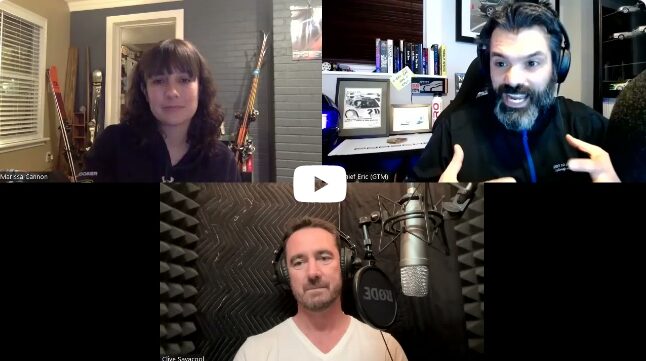
All of our BEHIND THE SCENES (BTS) Break/Fix episodes are raw and unedited, and expressly shared with the permission and consent of our guests.
Whether you prefer road racing, motocross, or supercross, motorcycle racing has something for everyone. Motorcycle racing is an exhilarating sport that offers a thrilling experience for both riders and spectators alike. With high-speeds, tight corners, and intense battles for position, it’s a sport that tests the limits of both man and machine. If you have questions, you can always reach out to Clive via LinkedIn.
The American Federation of Motorcyclists (AFM)
 |
For those looking to get involved in the sport, motorcycle racing offers a variety of opportunities to participate, from amateur races to professional circuits. With a wide range of classes and divisions, riders of all skill levels can find a place to compete and challenge themselves. So if you’re looking for a thrilling and adrenaline-fueled sport, consider motorcycle racing.
It’s a world of speed, excitement, and endless possibilities, and it’s waiting for you to join in on the action so be sure to check out organizations like the American Federation of Motorcyclists at www.afmracing.org, @afmsports on facebook, @afmracing on Instagram, and @raceafm on YouTube for more information.


